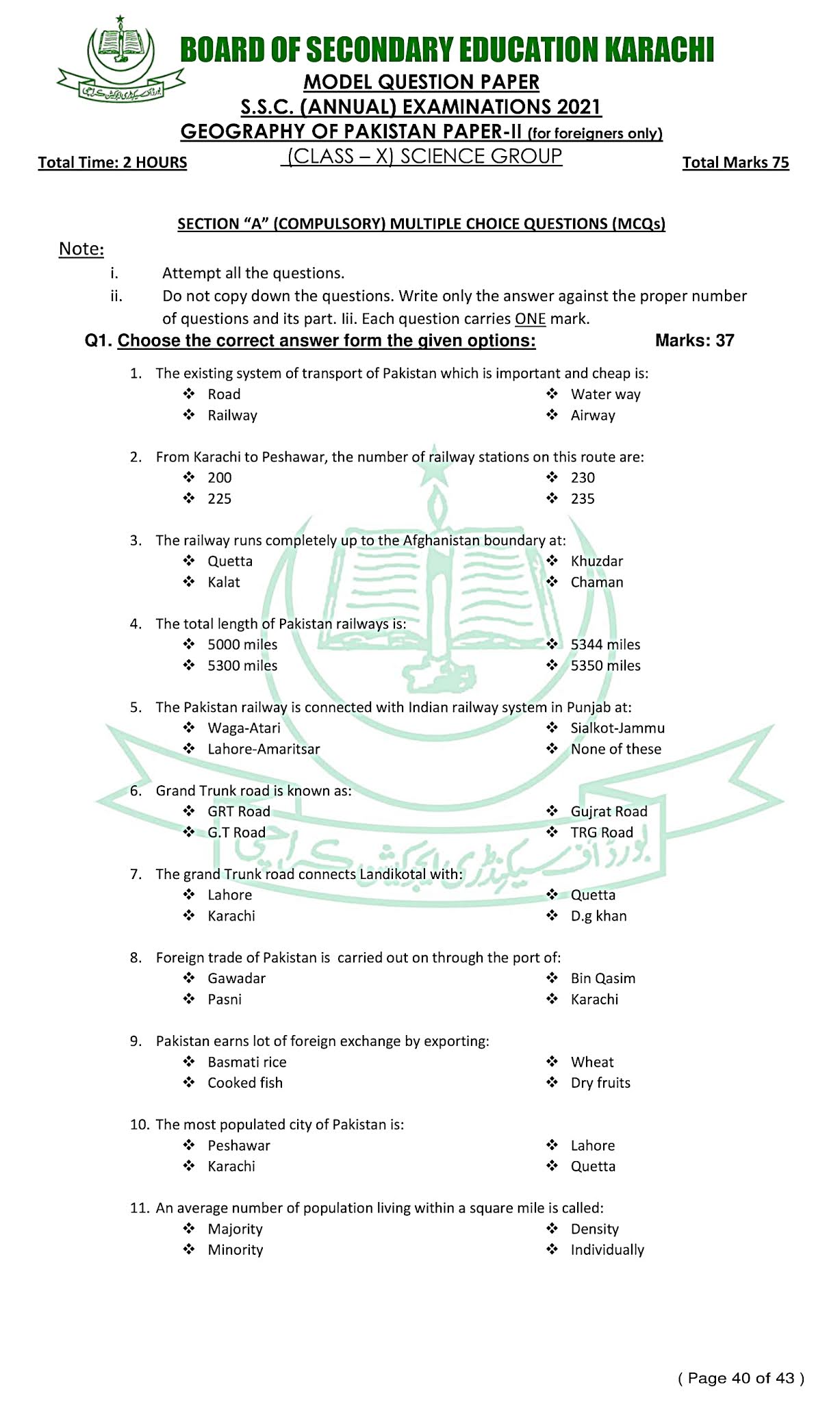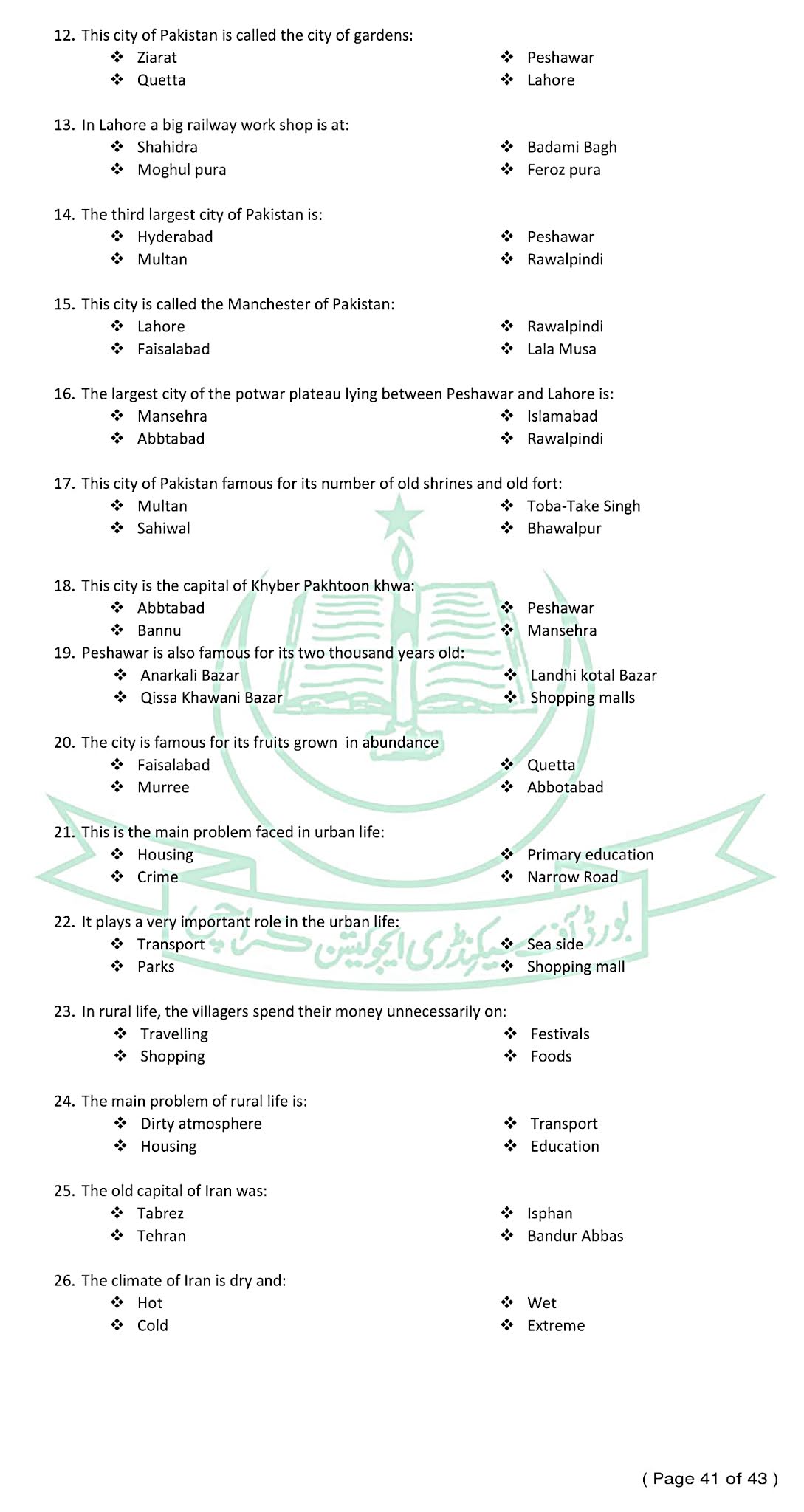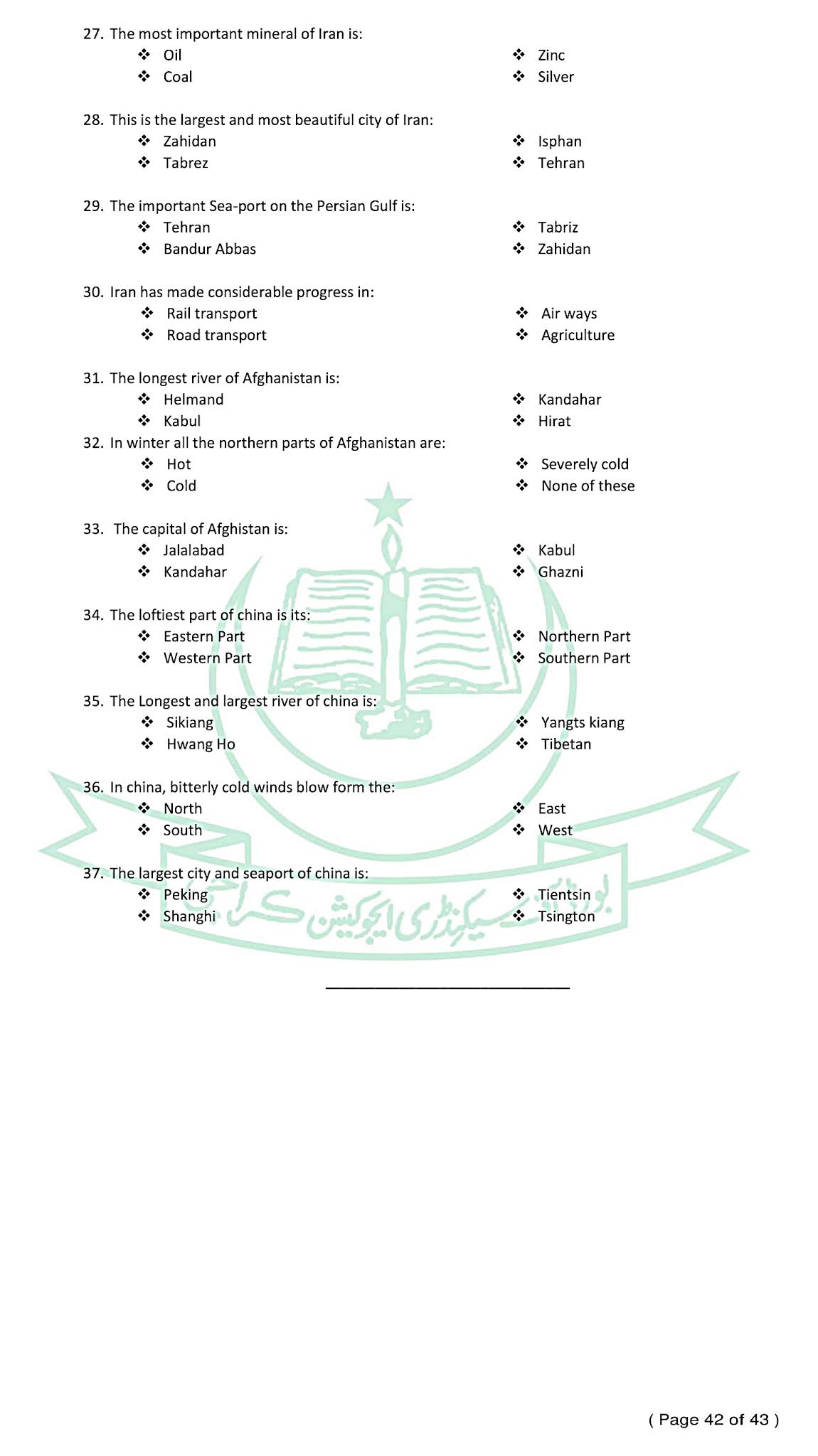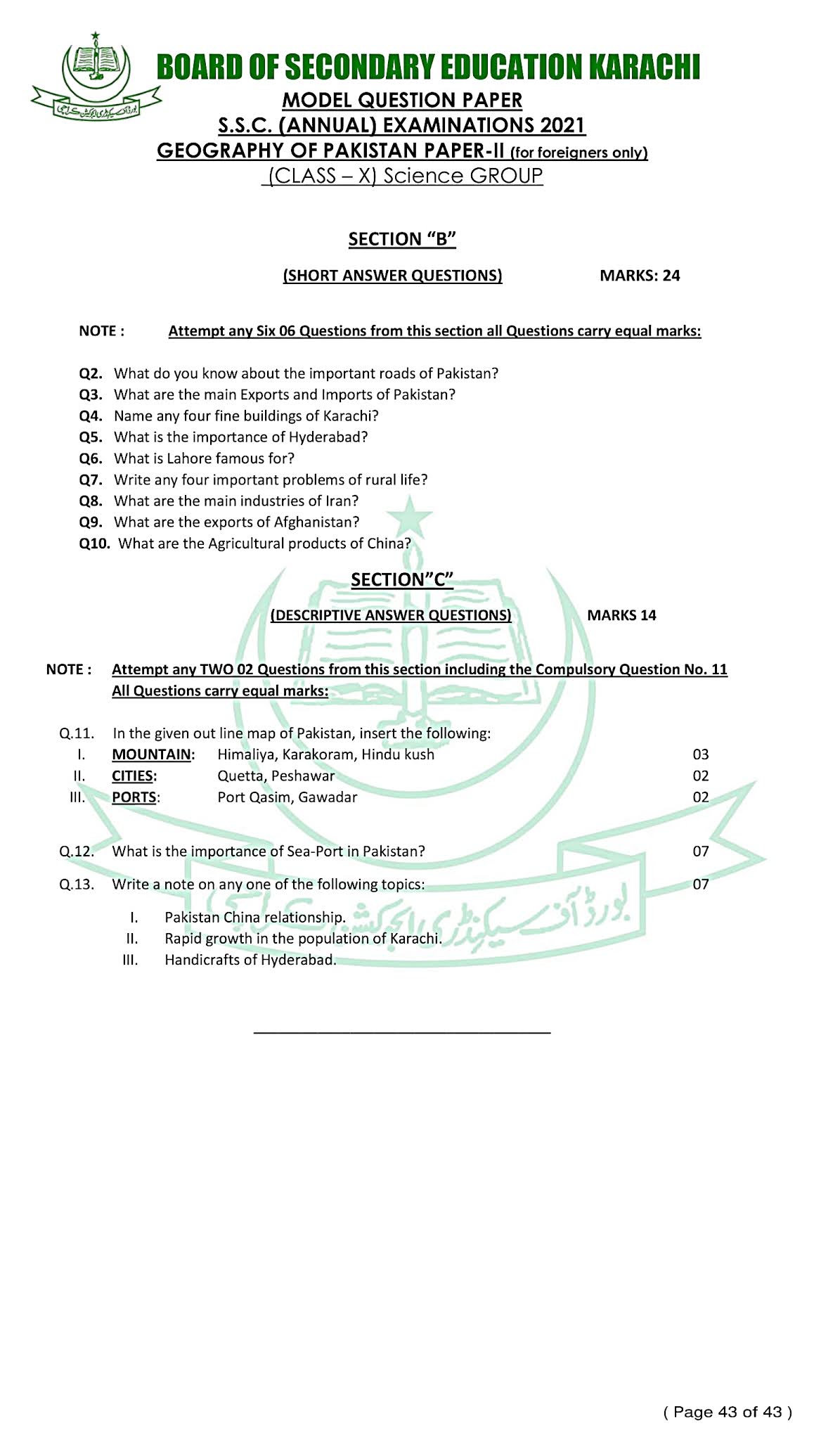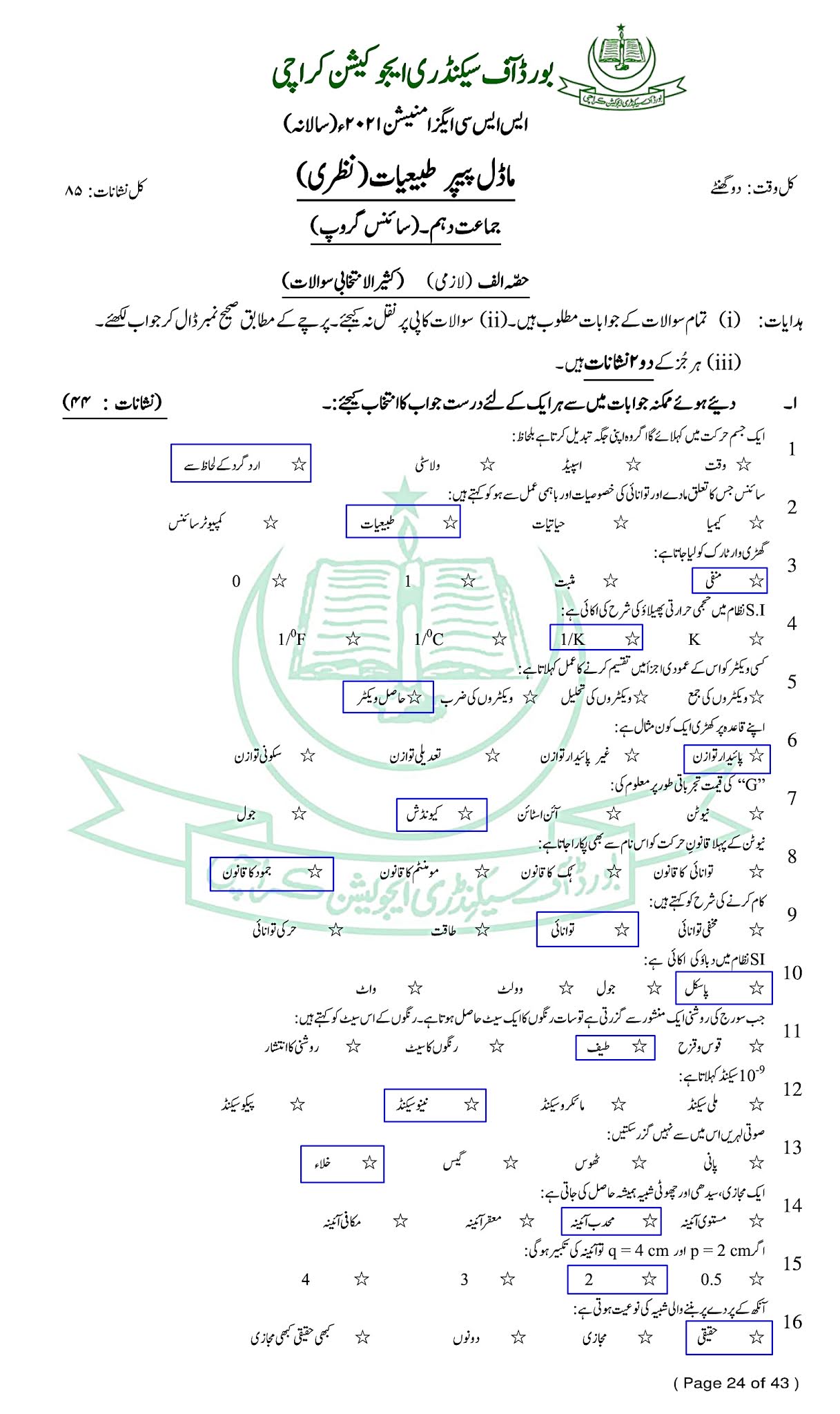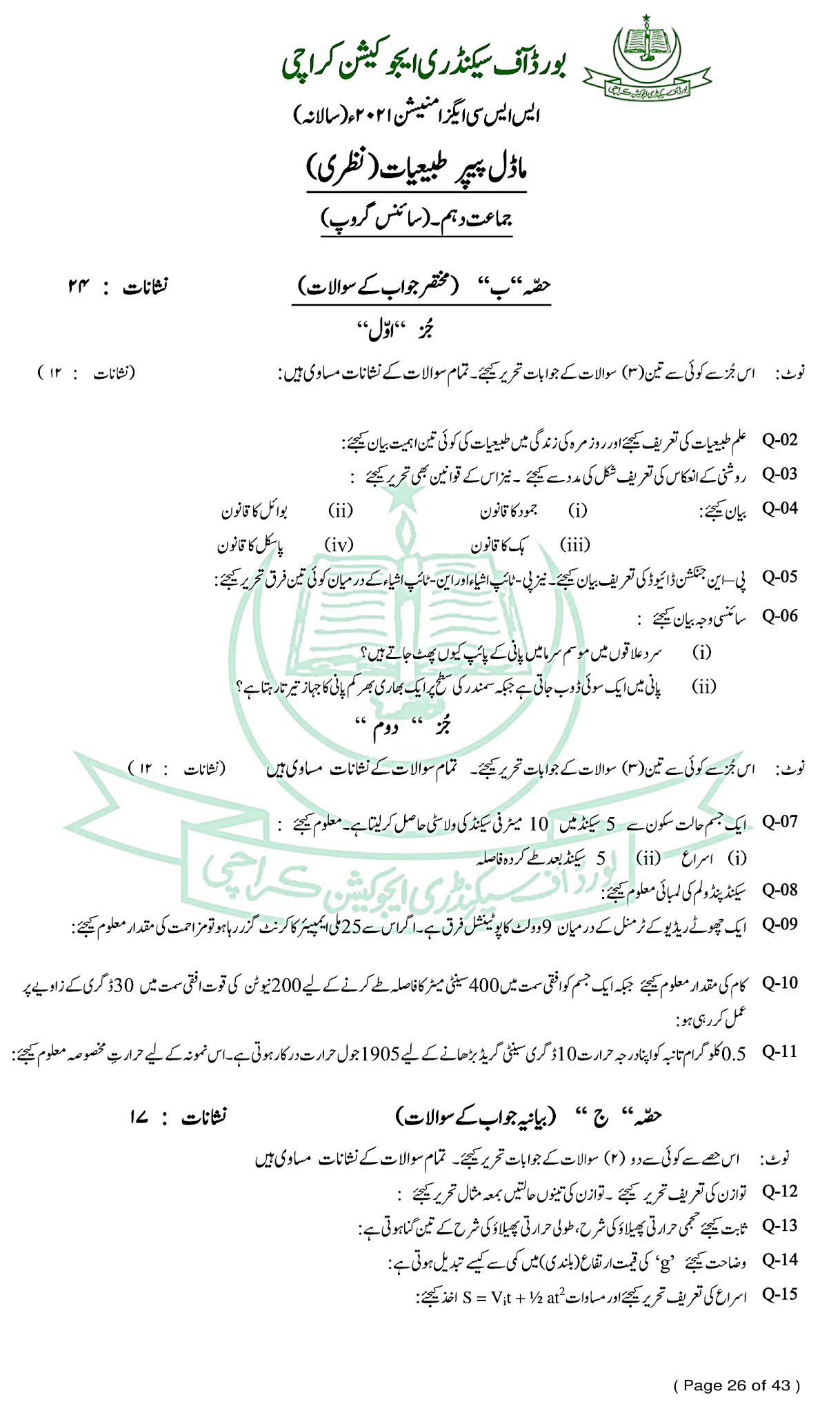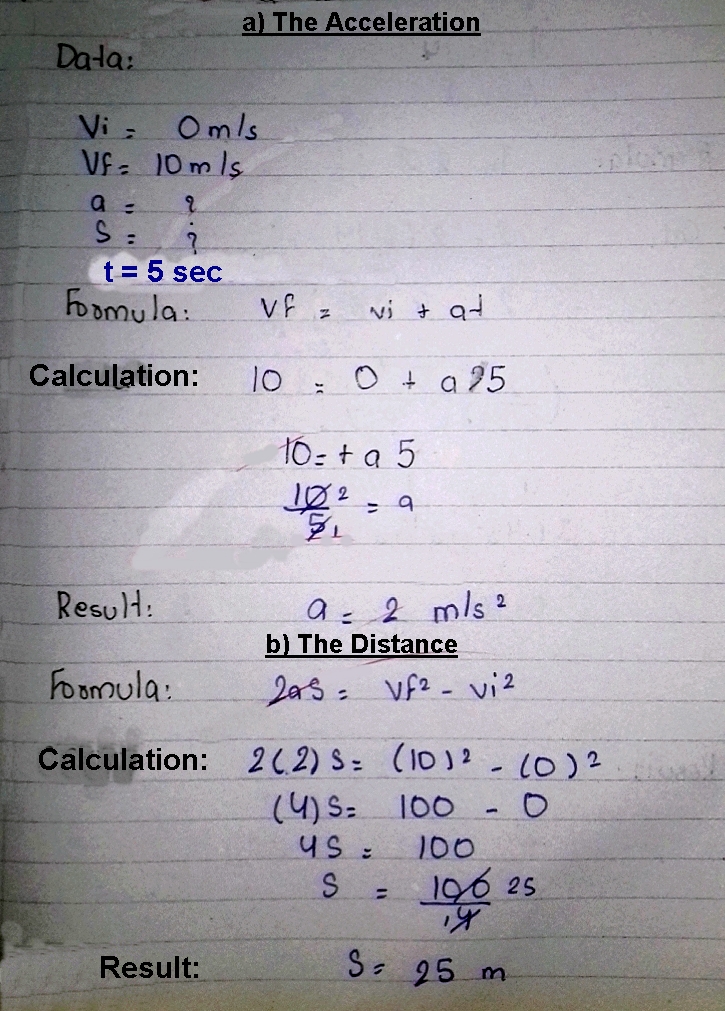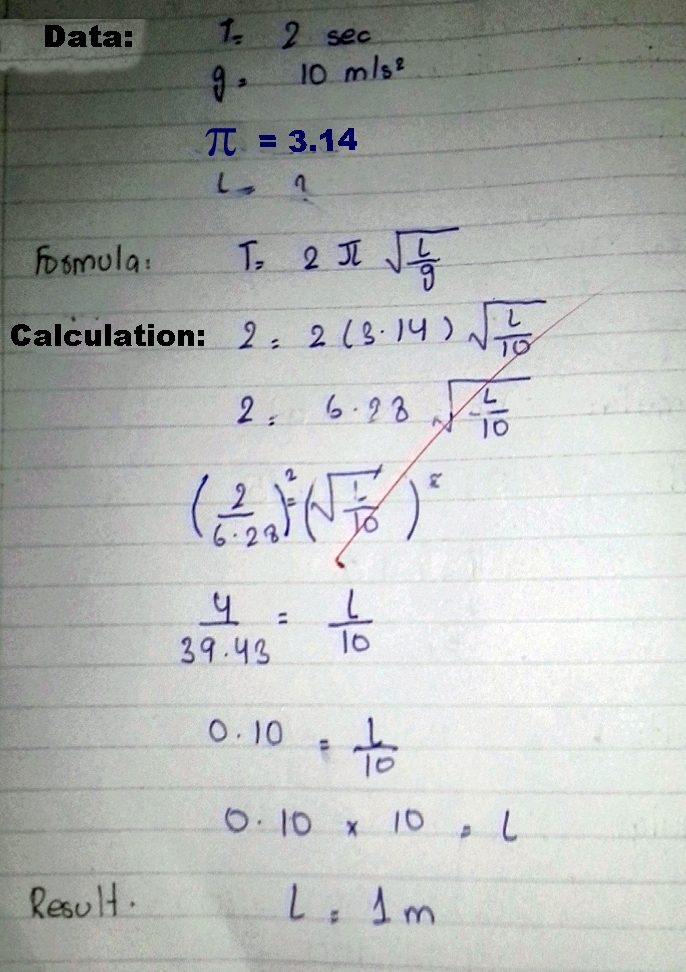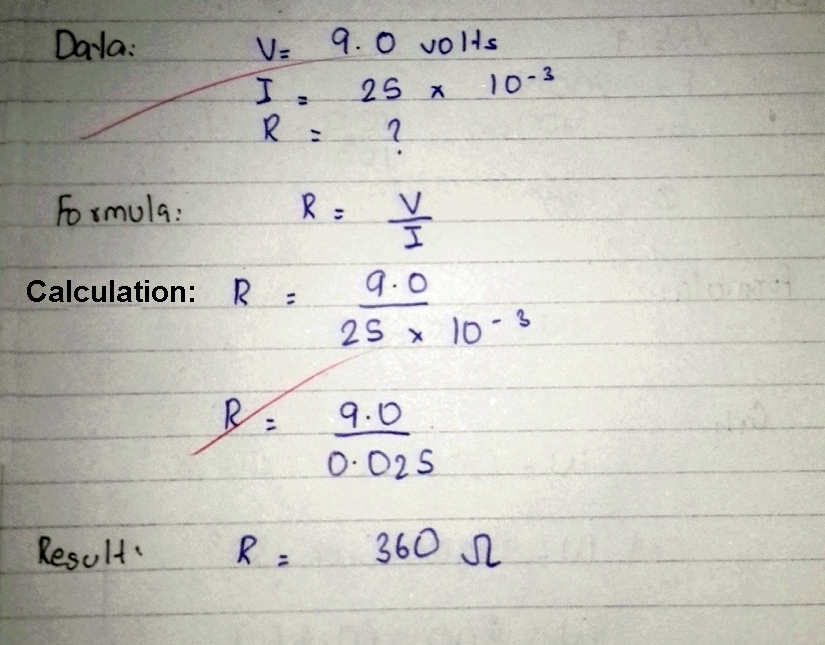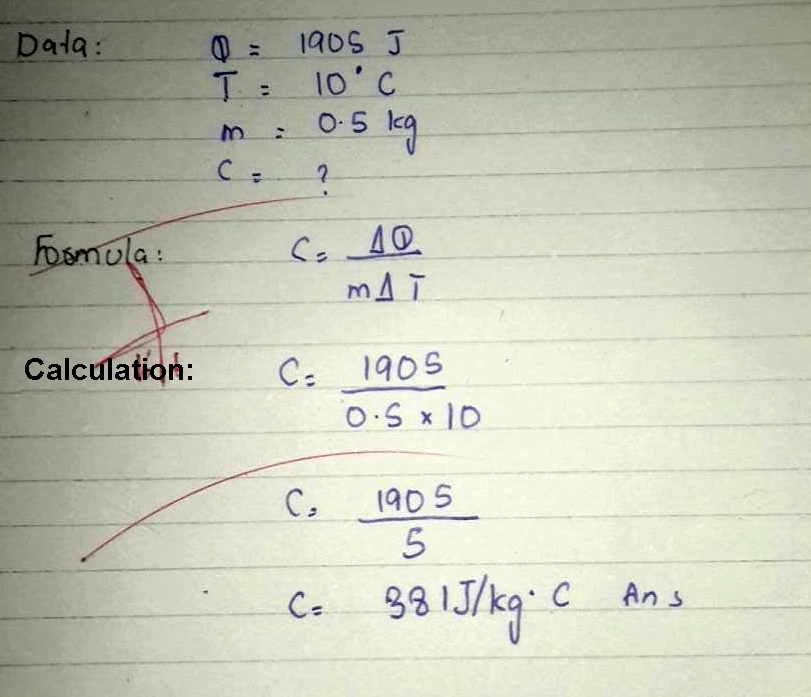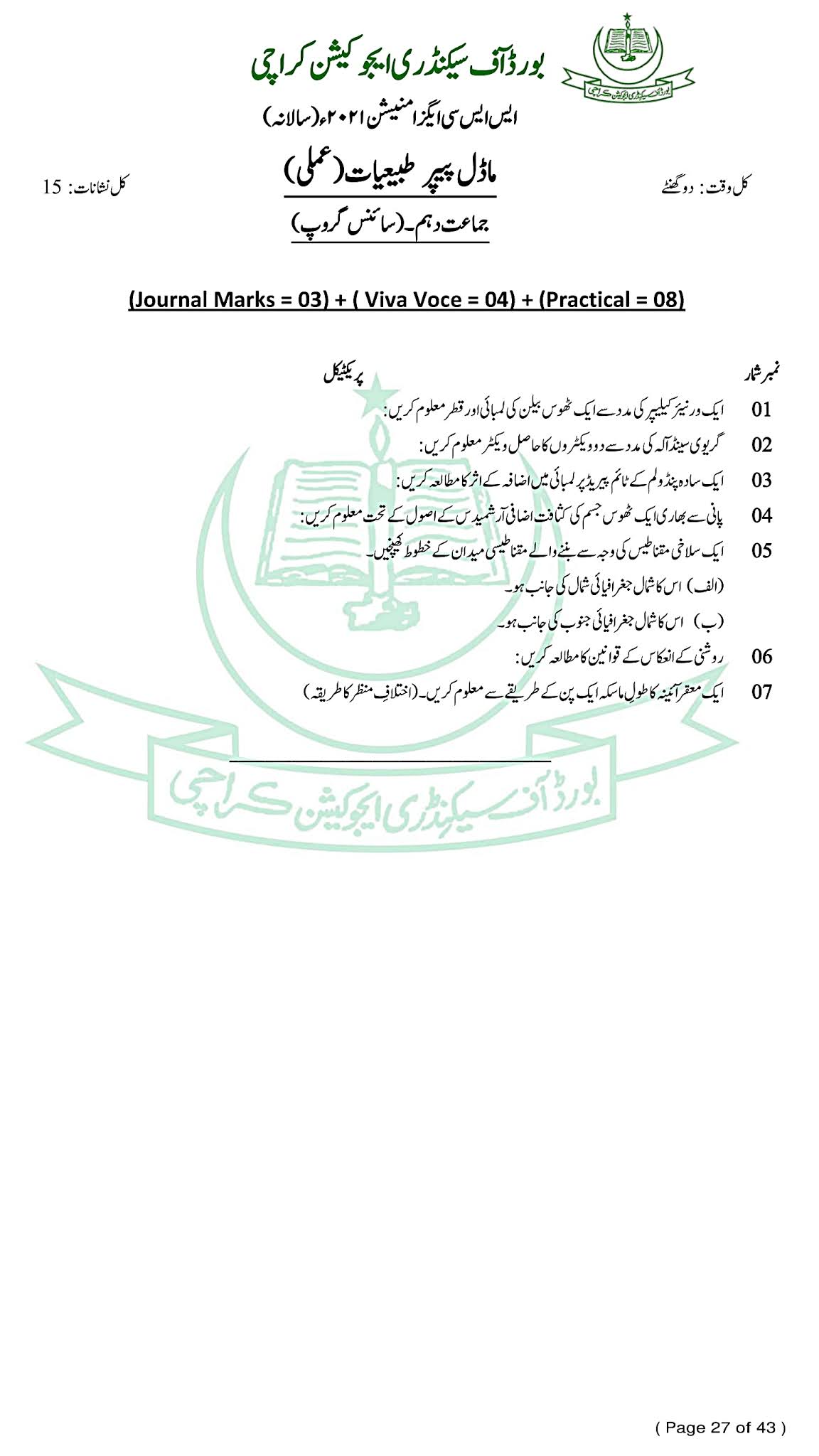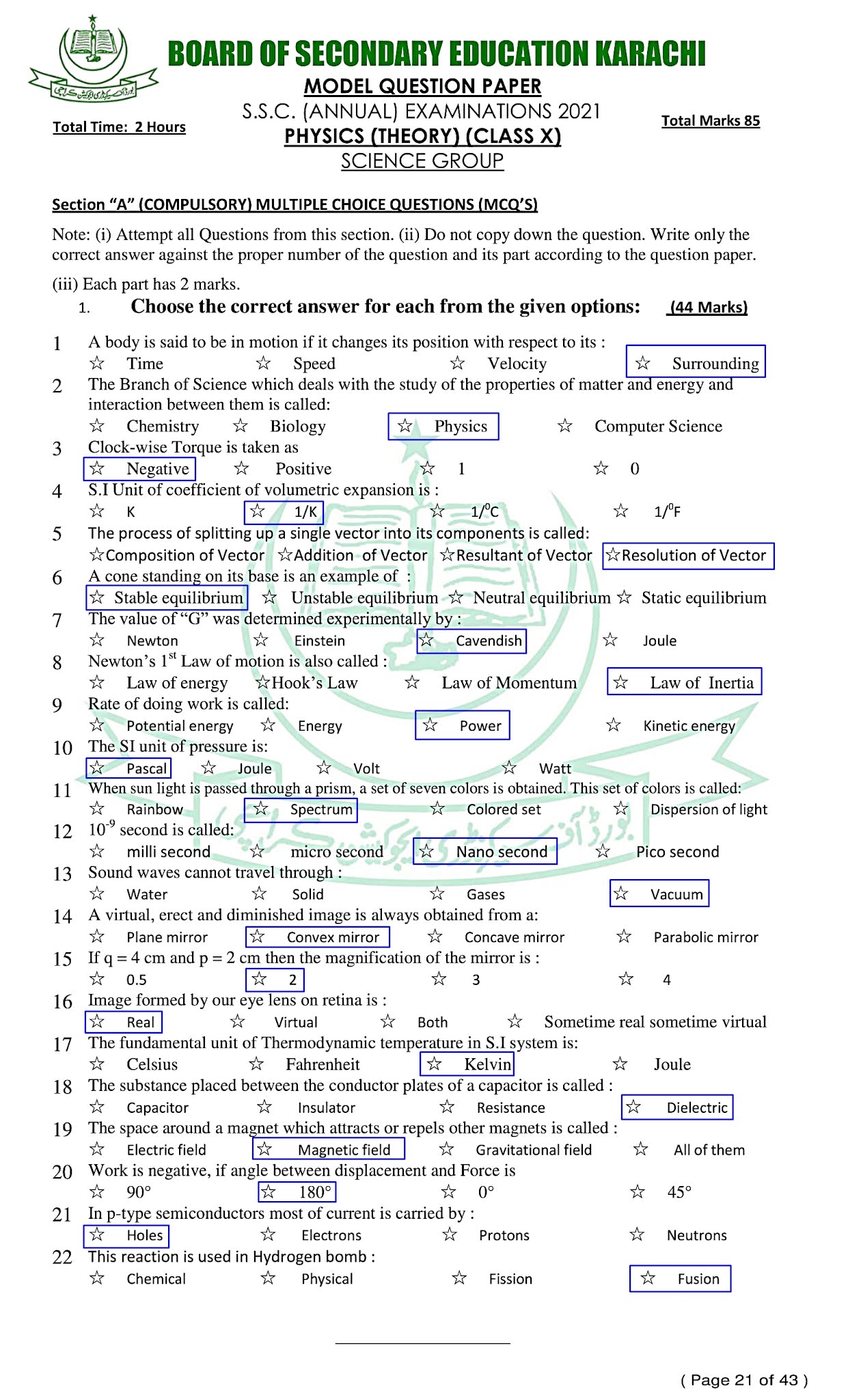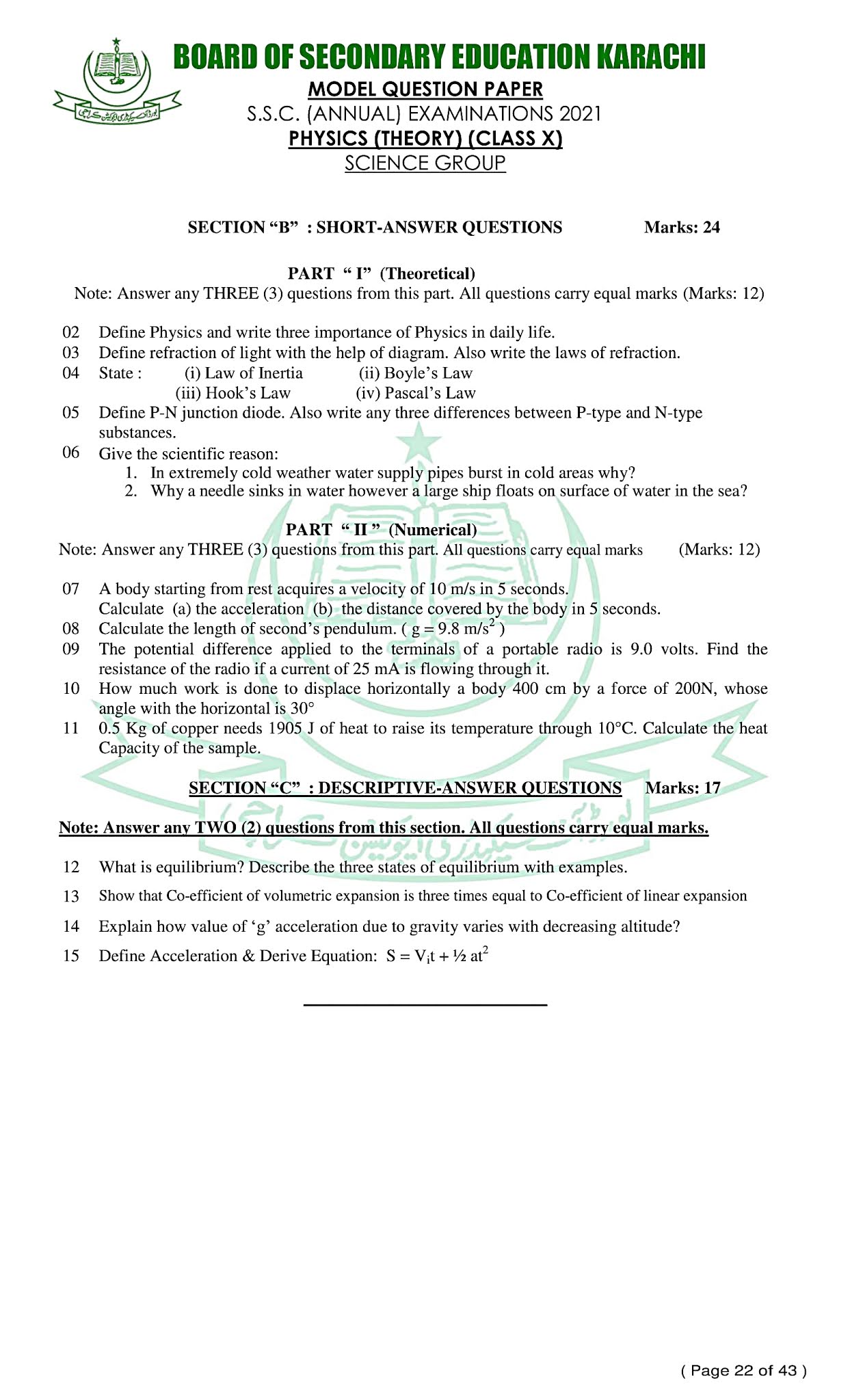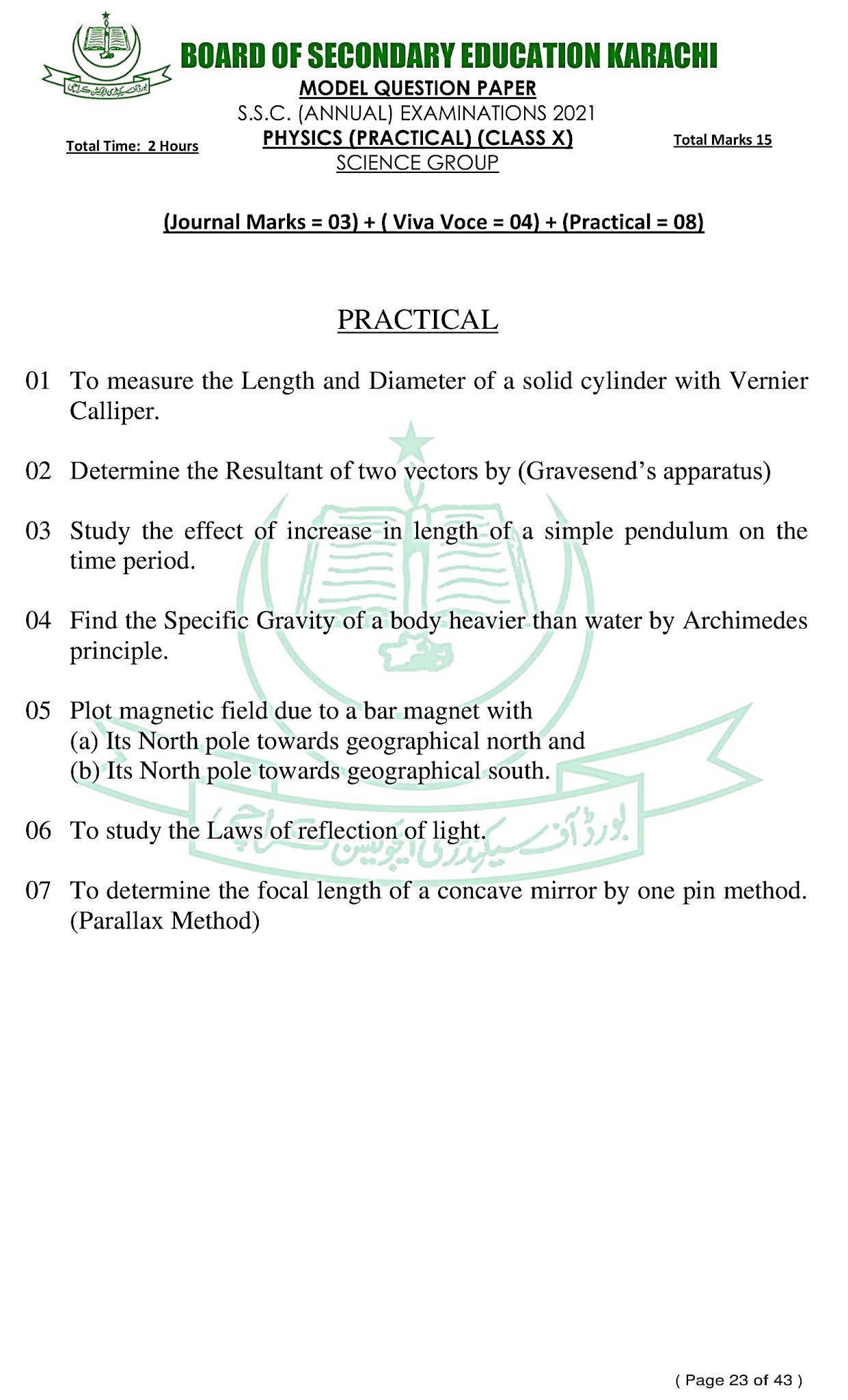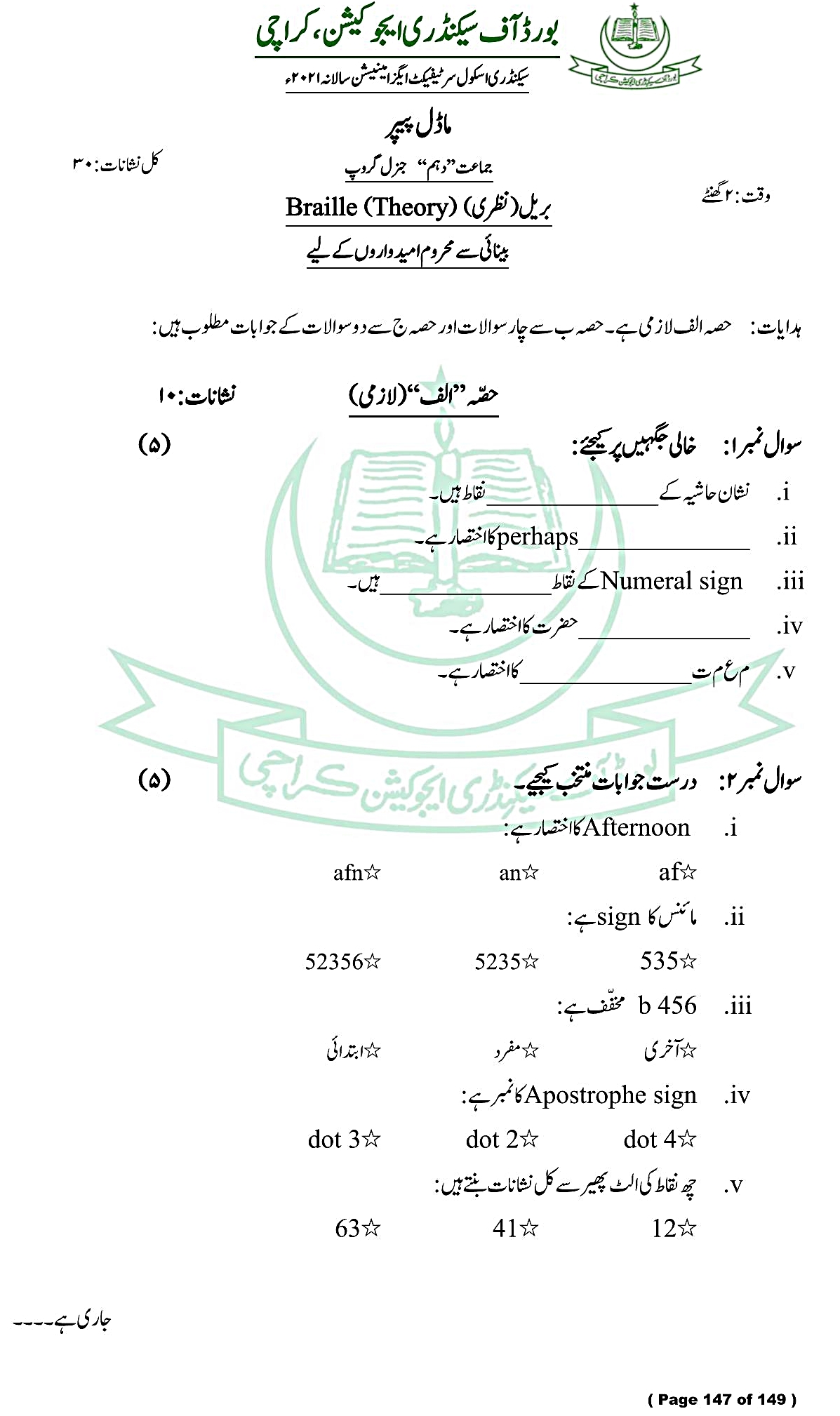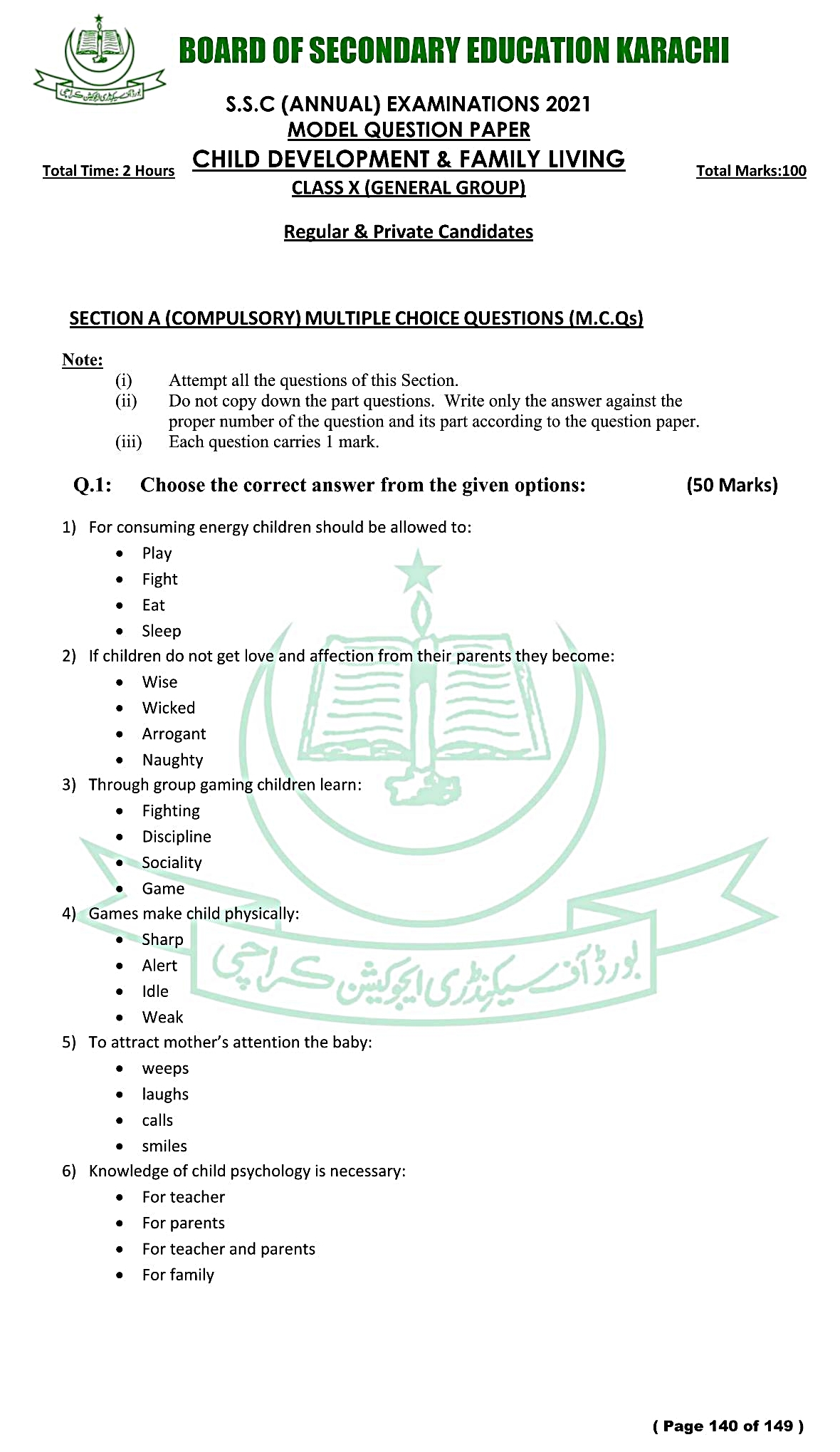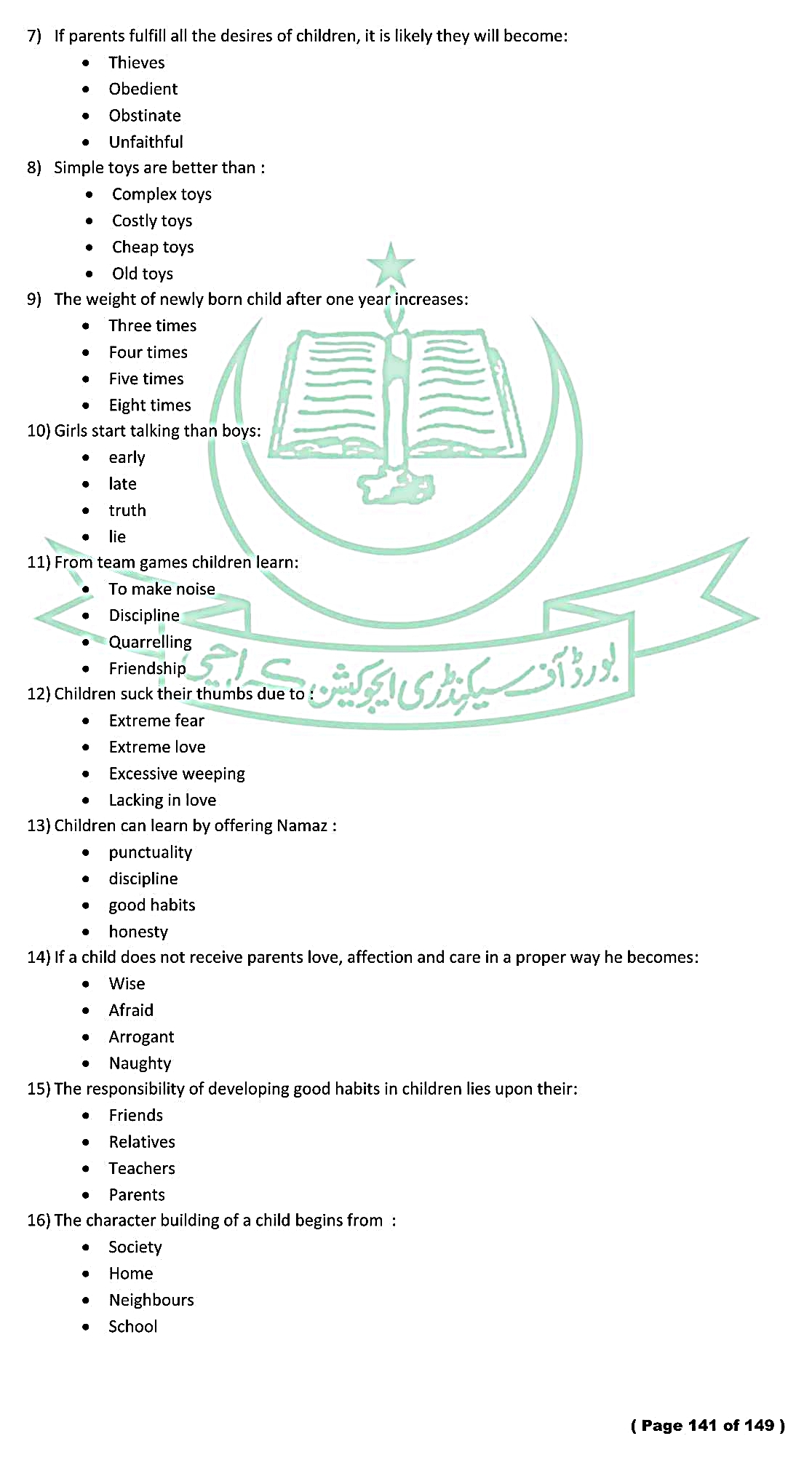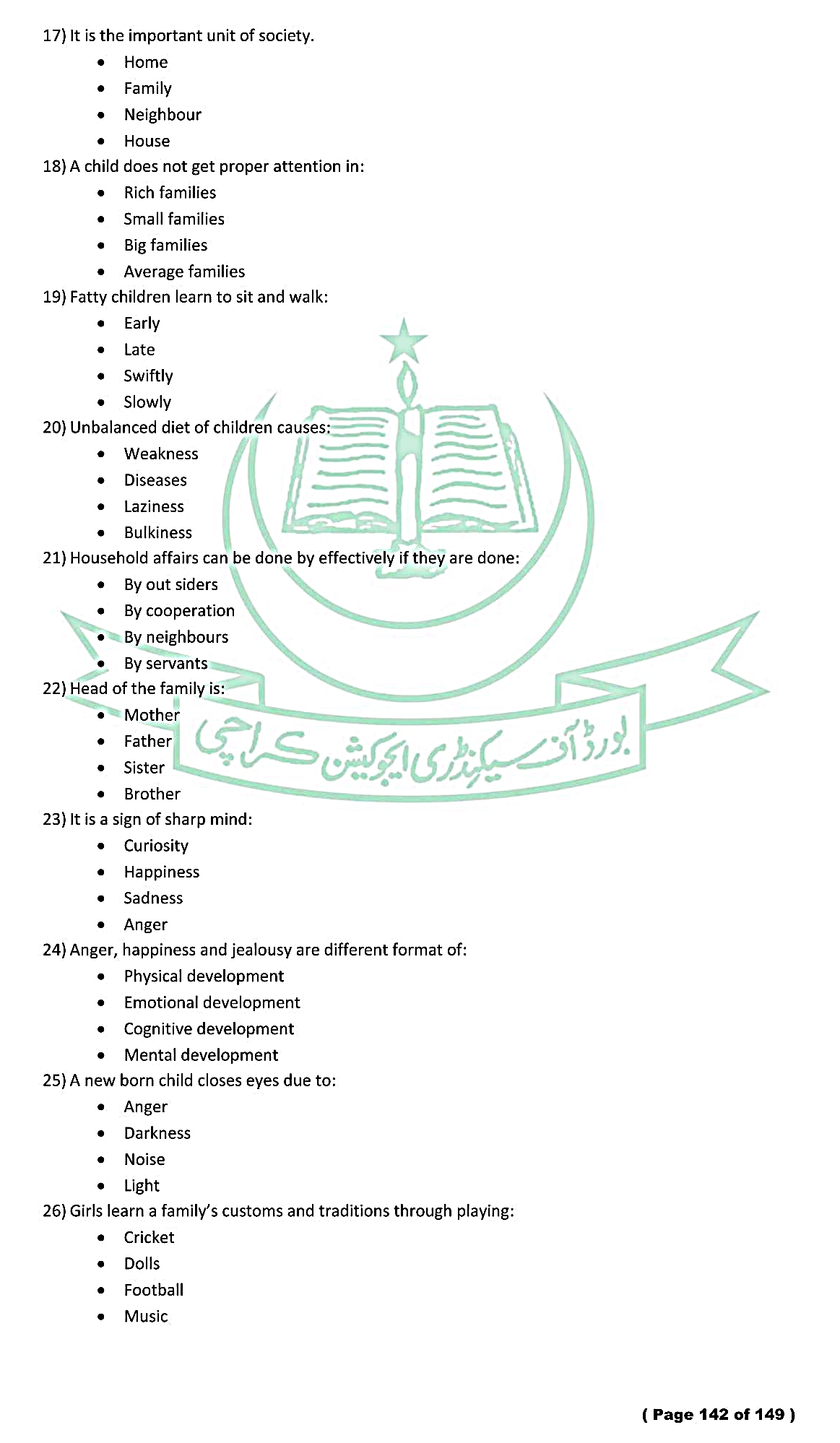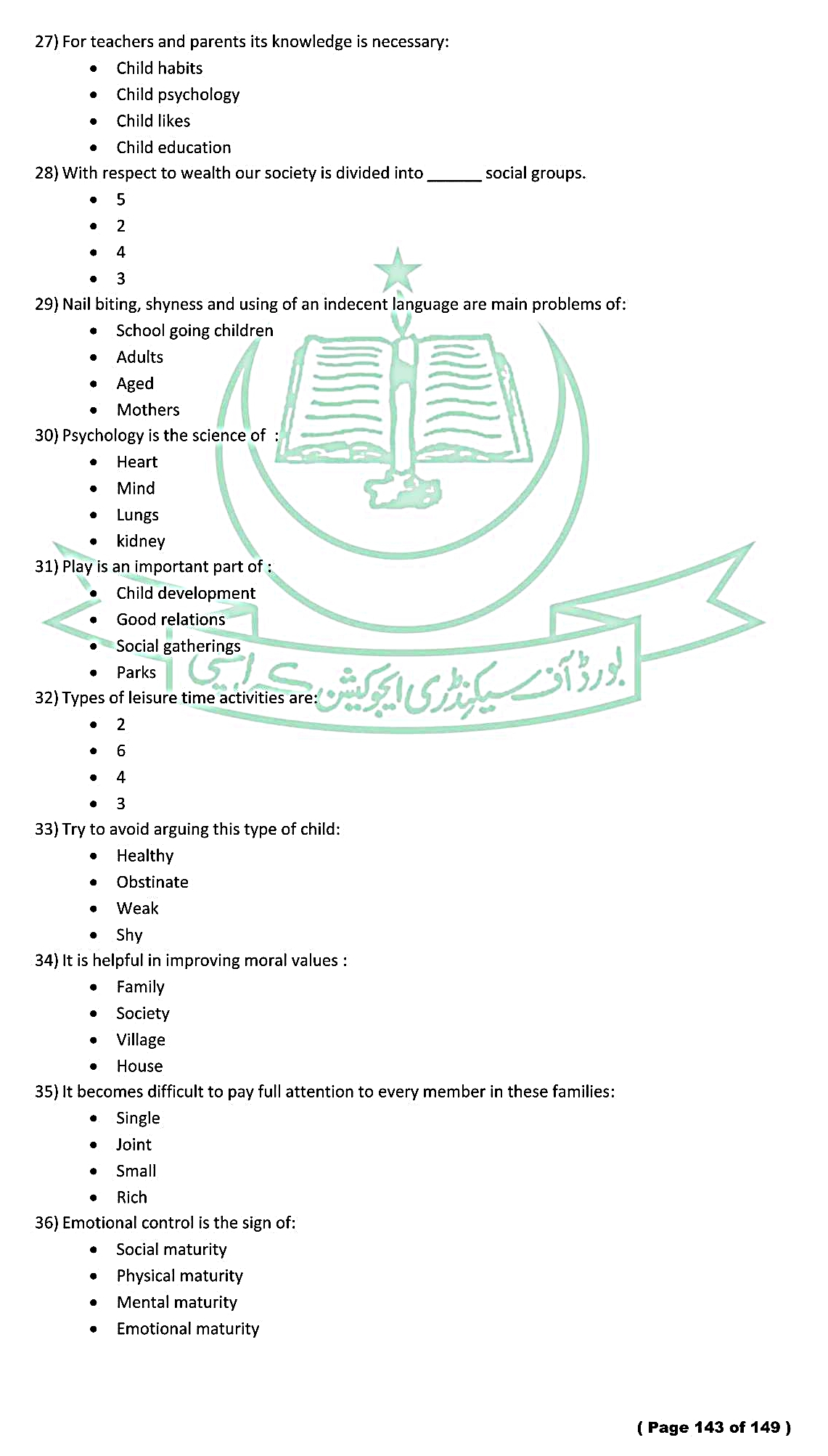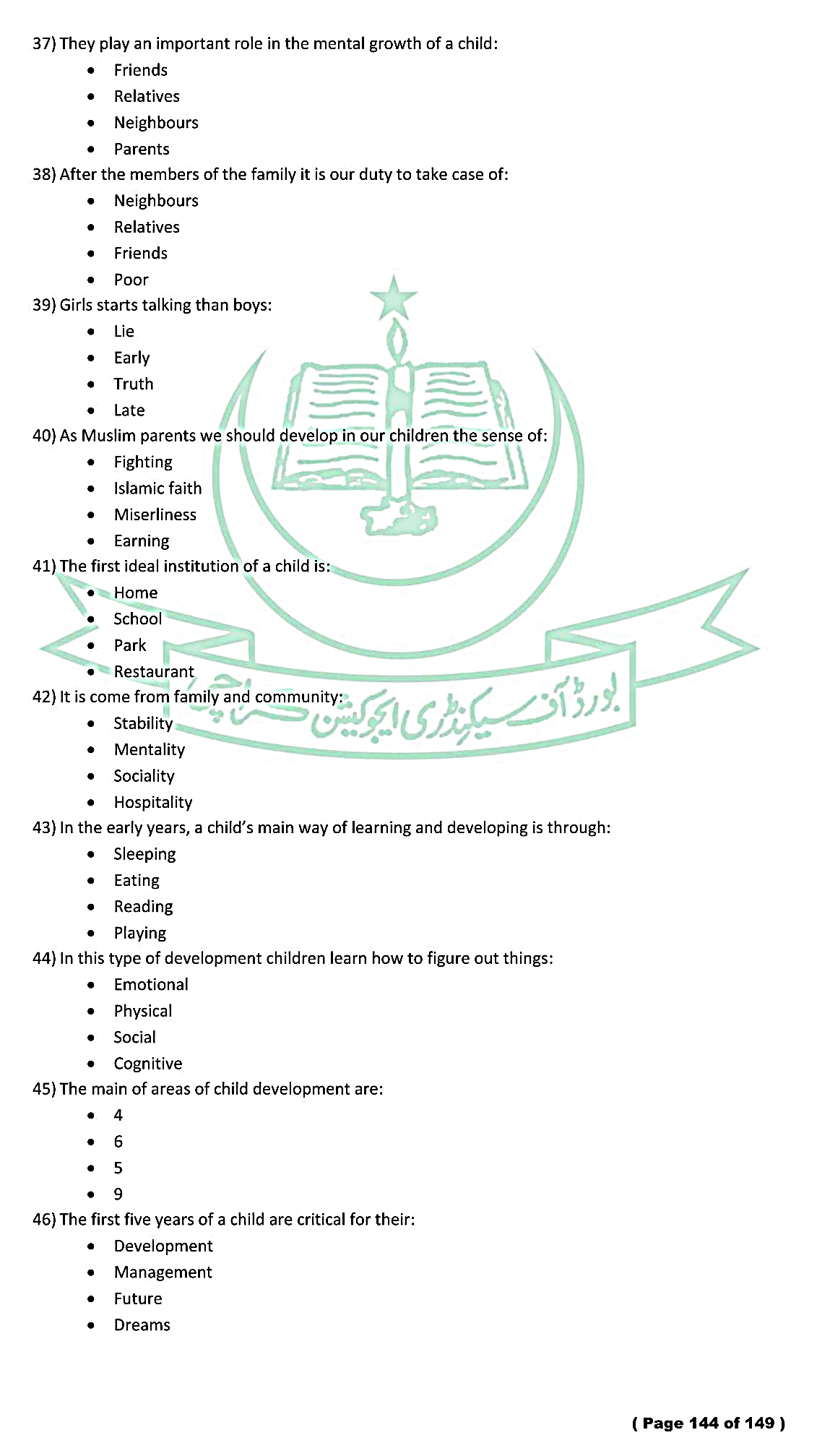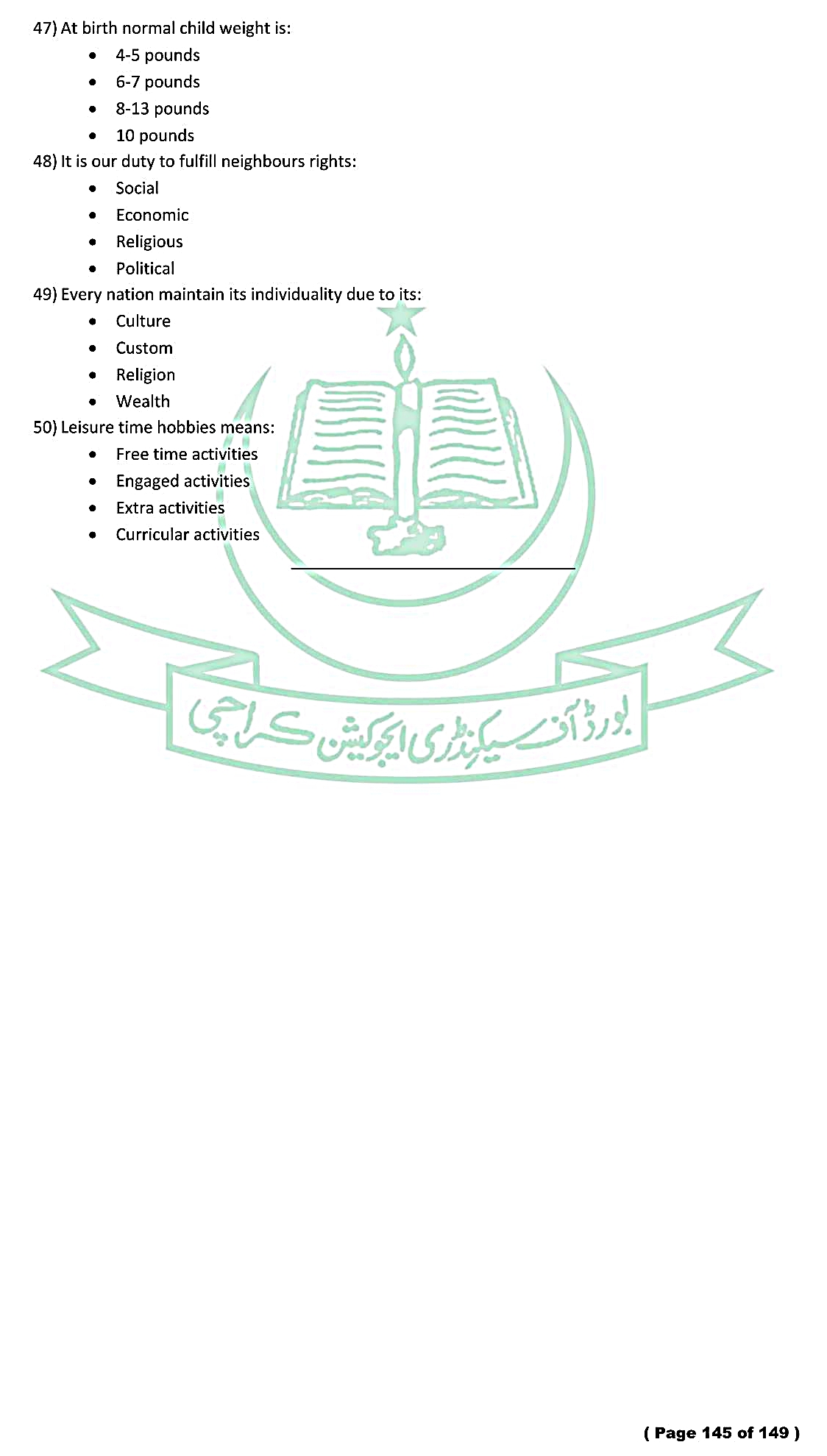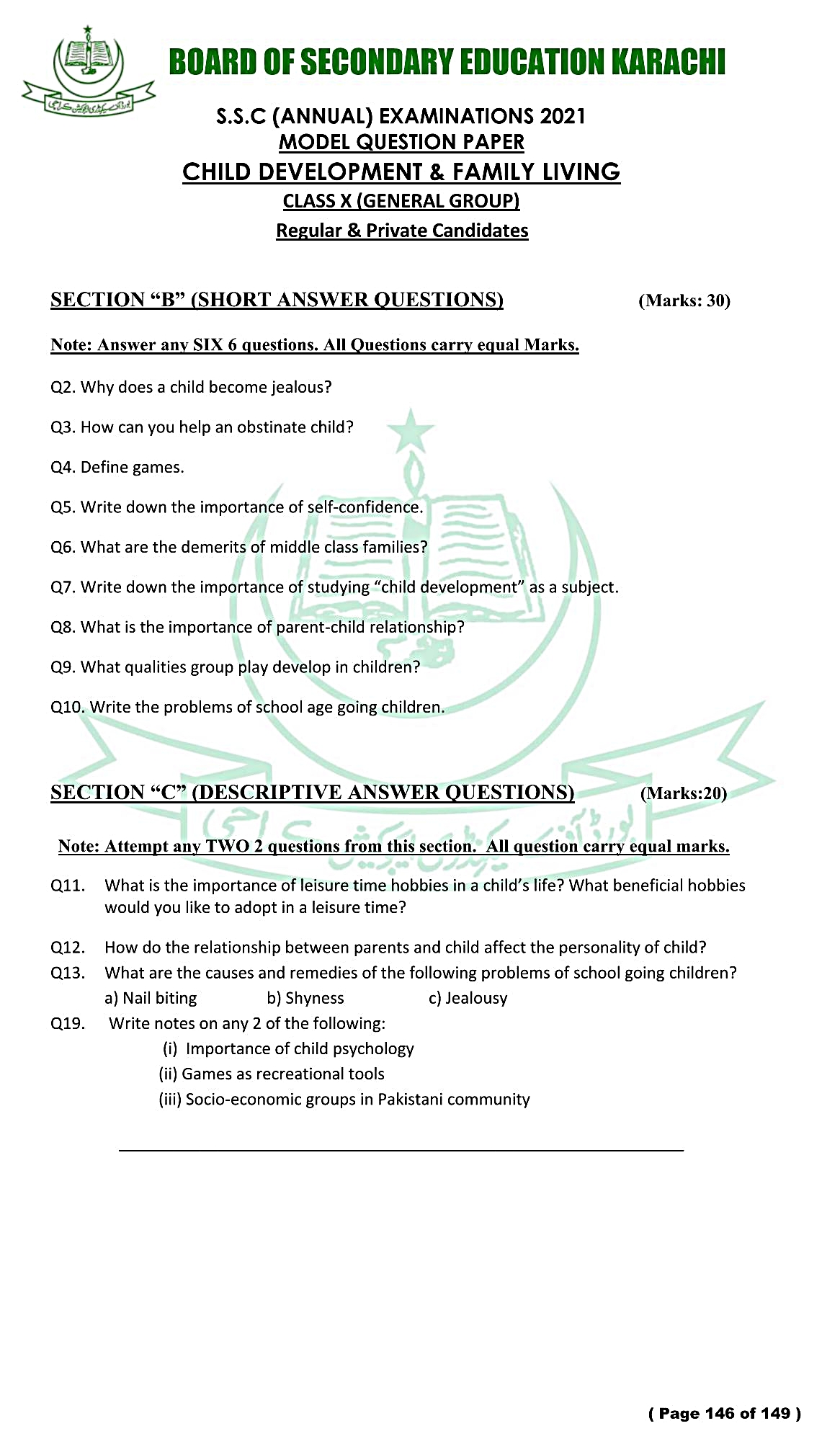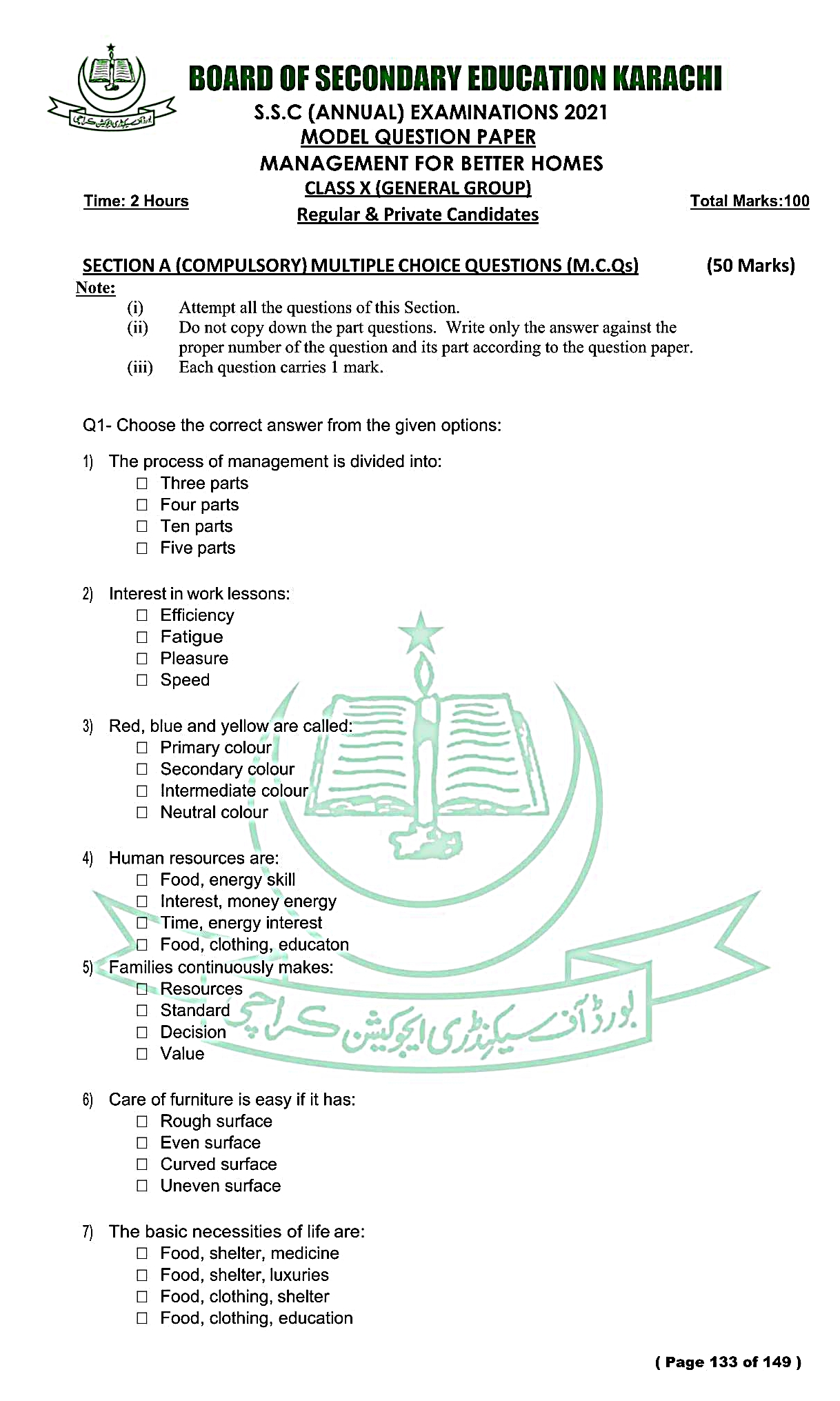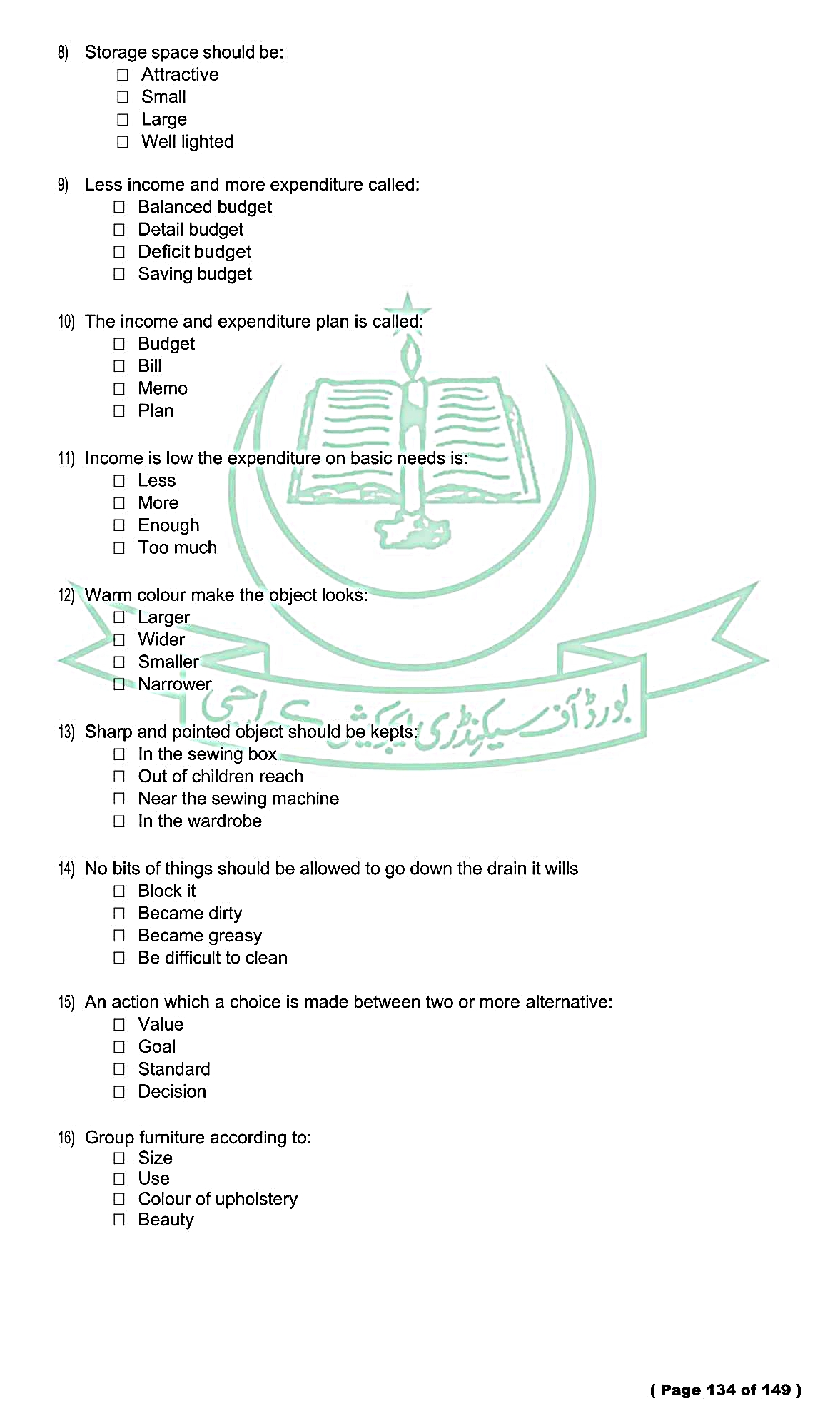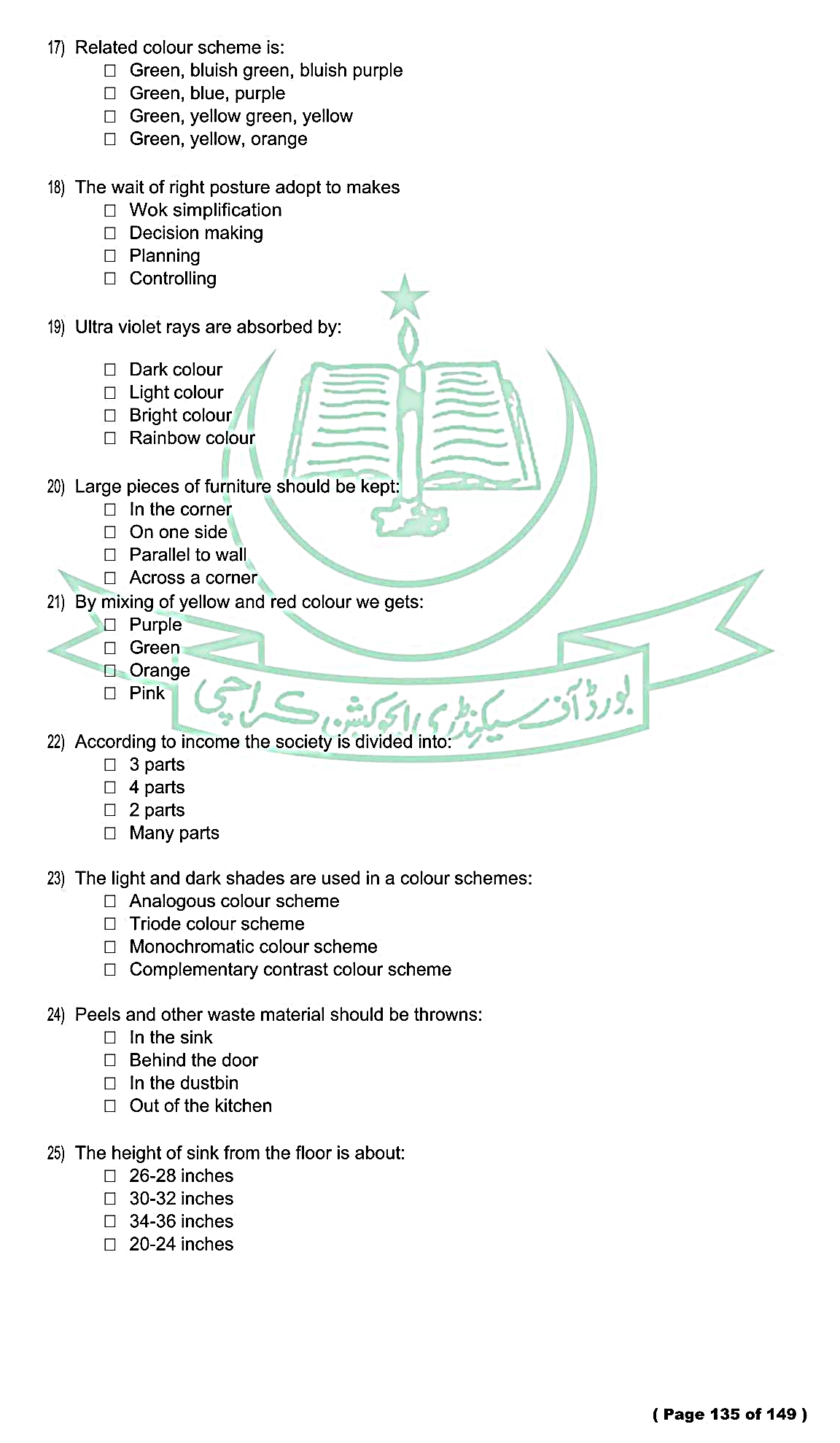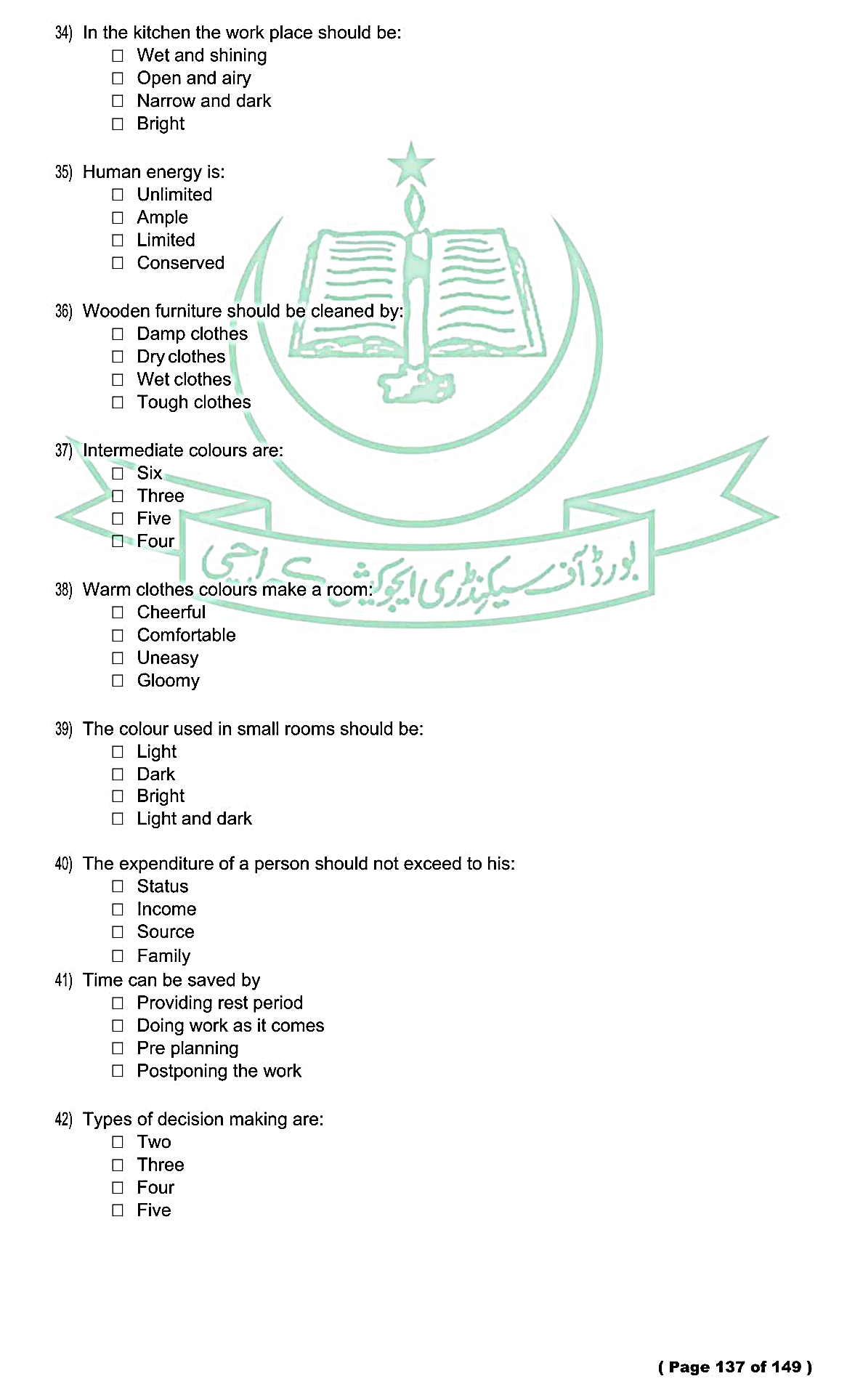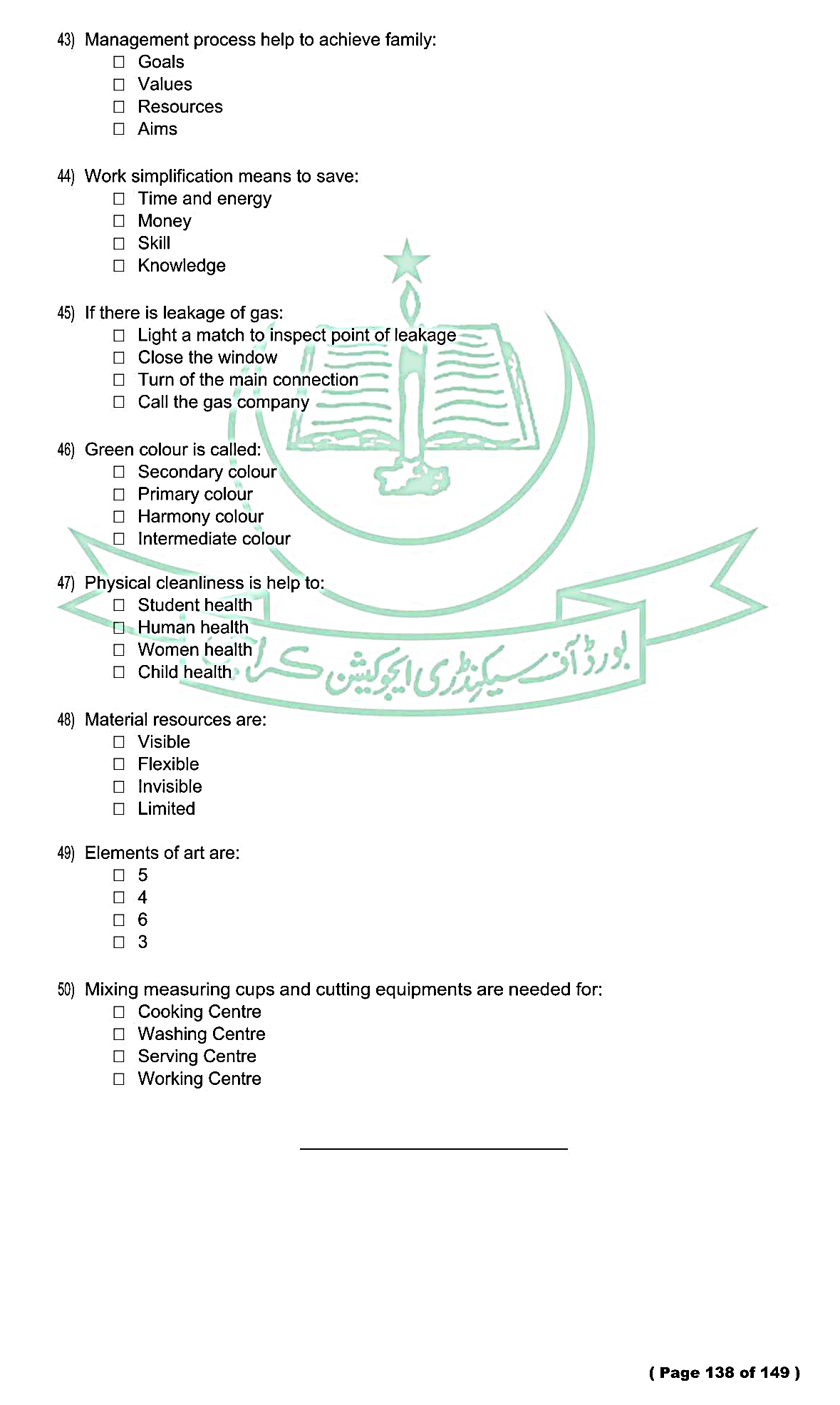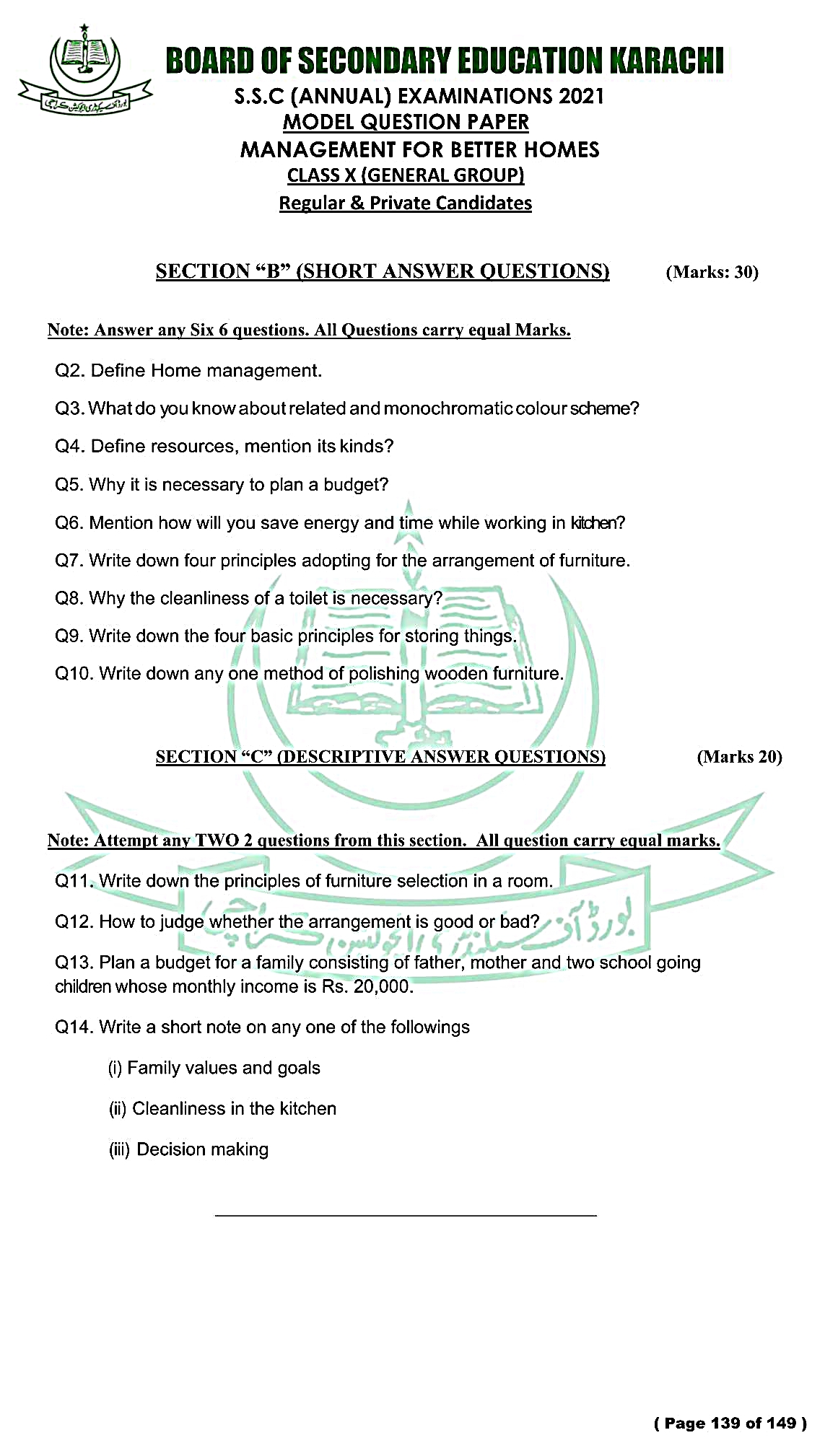GO TO INDEX
CHAPTER 7
BIOENERGETICS
By Mrs. Ayesha Arif
(Jauhar Progressive School)
Review Questions
1. Encircle the correct answer:i) In an oxidation process 14135 KJ energy is release, how many moles of glucose consume during this process.
(a) 1
(b) 3
(c) 5 ✔
(d) 10
(ii) Stage of aerobic respiration takes place at the cristae of mitochondria called:
(a) Electron transport chain ✔
(b) Glycolysis
(c) Kreb's cycle
(d) C3 cycle
(iii) In a process of cellular respiration 180 ATP molecules are produced, how many moles of glucose consume during this process.
(a) 2
(b) 5 ✔
(c) 8
(d) 10
(iv) Loss of electron and proton is called:
(I) Oxidation reaction
(II) Reduction reaction
(III) Redox reaction
(a) I only ✔
(b) I and II
(c) II and III
(d) I, II and III
(v) Each mole of ATP store energy:
(a) 7.3 kcal/mole ✔
(b) 7.3 kj/mole
(c) 17.3 kcal/mole
(d) 17.3kj/mole
(vi) Fundamental molecule produced during photosynthesis is:
(a) Glucose ✔
(b) Amino acid
(c) Fatty acid
(d) Nucleotide
(vii) Light dependent reaction takes place in:
(a) Stroma
(b) Thylakoid ✔
(c) Cristae
(d) Cisternae
(viii) Reaction in which solar energy is transferred to glucose from ATP and NADPH2 , takes place in stroma called:
(I) Light reaction
(II) Dark reaction (III) Light dependent reaction
(a) I only
(b) II only ✔
(c) I and II
(d) II and III
(ix) Splitting of water in presence of light called:
(a) Hydrolysis
(b) Glycolysis
(c) Photolysis ✔
(d) None of these
(x) Splitting of glucose (glycolysis) release small amount of energy which is enough to generate:
(a) 2 ATP ✔
(b) 5 ATP
(c) 18 ATP
(d) 36 ATP
2. Fill in the blanks:
(i) The only source of energy on earth is Sun.
(ii) Conversion of free energy into different forms by living organisms is called bioenergetics.
(iii) In living organisms energy is stored in a special molecule called ATP.
(iv) Plant utilizes simple inorganic molecules (CO2 and H2O) to prepare glucose and oxygen.
(v) Feeding sequences and relationships are called food chains.
(vi) Photosynthesis is the only process which produces free O2 by splitting water.
(vii) Chloroplast is double membrane bounded organelle have semifluid protein containing membrane called stroma.
(viii) In chloroplast different pigments absorb light of different wavelength.
(ix) The breakdown of food molecules to release energy is called respiration.
(x) Each mole of glucose produce maximum energy i.e.2827 Kj.
3. Define the following terms:
- Bioenergetics
- Energy
- Oxidation reaction
- Food chain
- Granum
- Photolysis
- Fermentation
- Stroma
- Aerobic respiration
- Pyruvic acid
Ans: (i) BIOENERGETICS:
"The study about conversion of free energy into different forms by living organisms is called Bioenergetics."
Bioenergetics can also be defined as:"The study of energy relationships, energy transformation and transmission in living organisms."
It is the part of biology, Physics and chemistry concerned with the energy involved in making and breaking of chemical bonds found in the molecules of organisms.(ii) ENERGY:
Energy is the capacity for doing work. The only source of energy on earth is Sun. Energy can neither be created nor be destroyed but it can change from one form to another form. It may exist in potential, kinetic, thermal, electrical, chemical, nuclear, or other various forms.
(iii) The Oxidation Reactions:
are those reactions in which loss of electron (e-) and proton (H+) occurs. These electrons carry energy from the molecules from where they release to the molecules where they added. e.g.
Iron reacts with oxygen to form a chemical called rust, in this reaction iron (Fe) loses some e- which transfer to oxygen. In this reaction Fe is oxidized and it transfers its energy to oxygen through electrons.
(iv) Food chain:
In ecology, food chain is the sequence of transfers of matter and energy in the form of food from organism to organism. In other words, the feeding sequences and relationship are called food chains.
OR
A food chain is a linear sequence of organisms through which nutrients and energy pass as one organism eats another. Therefore these feeding sequences and relationships are called food chain.(v) Granum (pl. grana):
It is a stack of plate-like bodies (thylakoids), many of which are found in plant chloroplasts (each chloroplast contains about 50 grana). Grana bear the light receptive pigment chlorophyll and contain the enzymes responsible for the light-dependent reactions of photosynthesis.
OR
It is a stacked membranous structure within the chloroplasts of plants and green algae that contain the chlorophyll and are the site of the light reactions of photosynthesis. The sac like membranes that make up grana are known as thylakoids.(vi) Photolysis:
Some of the light is utilized to split water into oxygen and H+ with e- (electron), this splitting of water is called Photolysis. Oxygen which is produced during photolysis is released in the environment where as H+ together with CO2 are used in building glucose.
(vii) Fermentation:
Fermentation is a metabolic process that produces chemical changes in organic substrates through the action of enzymes and breaks down into a simpler substance.
In biochemistry, it is narrowly defined as:
The primitive type of respiration which takes place in the absence of O2 or without O2 is called anaerobic respiration or fermentation. There are special conditions where O2 is not available so the organisms adapt themselves to break down their food without oxygen which is called anaerobic respiration or fermentation.
Example:
It takes place in some bacteria, fungi, endoparasite and sometimes in animal.
(viii) Stroma:
Chloroplast have semi-fluid proteins containing medium called Stroma, which surrounding thylakoids and grana. Initially, the stroma was thought to simply provide support for the pigmented thylakoids. However it is now known that the stroma contains starch, chloroplast DNA and ribosomes, as well as all the enzymes required to carry light independent reactions of photosynthesis, also called Calvin-Benson cycle.
(ix) Aerobic Respiration:
Type of respiration where food breakdown occurs in the presence of oxygen to produce energy, is called aerobic respiration.
It takes place in the presence of free oxygen, oxidizing the food and releasing the maximum amount of energy i.e. 2827 kj / mole of glucose or 36 ATP molecules/glucose.
Example:
It is a method of respiration found in majority of organisms.
Equation:
The end products of aerobic respiration are CO2 and H2O.
Glucose + oxygen → Carbon dioxide + water + Energy (36 ATP)
C6H12O6 + 6O2 → 6CO2 + 6H2O + 36 ATP
C6H12O6 + 6O2 → 6CO2 + 6H2O + 36 ATP
(x) Pyruvic Acid:
Pyruvic acid, (CH3COCOOH), is an organic acid that probably occurs in all living cells. It ionizes to give a hydrogen ion and anion, termed pyruvate. Pyruvic acid can be made from glucose through glycolysis. It can also be used to construct the amino acid alanine and can be converted into ethanol or lactic acid via fermentation.
4. Distinguish between the following in tabulated form:
(i) Respiration and photosynthesis
(ii) Light reaction and Dark reaction
(iii) Aerobic respiration and anaerobic respiration
(i) Difference Between Photosynthesis & Respiration
| S.No. | Photosynthesis | Respiration |
|---|---|---|
| 1. | Photosynthesis is the process where light energy converted in chemical energy. | Respiration is the process where chemical energy converted into energy of ATP. |
| 2. | It occurs only in chlorophyll containing organisms. OR It takes place in green part i.e. chlorophyll of the cells of plants only. | It occurs in all organisms. OR It takes place in all living cells of plants and animals. |
| 3. | It requires light sources i.e occur only in the presence of light. (i.e. during day time only) | It does not requires light source so occurs throughout the life. (i.e. during day and night like.) |
| 4. | It occurs in chloroplast. | It occurs in mitochondria. |
| 5. | The reactants are Carbon dioxide and water. | Reactants are carbohydrates and oxygen usually. |
| 6. | The end products are glucose (simple carbohydrate) and oxygen. | The end products are carbon dioxide and water in the case of aerobic respiration |
| 7. | It is an anabolic process i.e. compounds are formed. | It is a catabolic process i.e. compounds are broken down. |
| 8. | Energy is used in this process and it is stored in the form of food material. | In respiration energy is released from food materials. |
| 9. | During this process carbon dioxide enters in the plant body and oxygen is given out. | During this process oxygen is entered in the body and carbon dioxide releases. |
| 10. | The chemical equation for this process is: 6CO2 + 6H2O → C6H12O6 + 6O2 | The chemical equation for this process is: C6H12O6 + 6O2 → 6CO2 + 6H2O + Energy |
| 11. | During the breakdown of one glucose, 38 ATP molecules are formed. | During the formation of one glucose, 18 ATP molecules are utilized. |
Difference Between Light Reaction And Dark Reaction
| S.No. | Light Reaction | Dark Reaction |
|---|---|---|
| 1. | It take place only in the presences of light | It takes place only in presence or absence of sunlight. |
| 2. | It is a photo-chemical phase. | It is a biochemical phase. |
| 3. | It takes place in the grana of the chloroplast | It takes place in the stroma of the chloroplast. |
| 4. | NADP utilizes H+ ions to form NADPH. | The hydrogen of NADPH combines with CO2. |
| 5. | The end products are ATP and NADPH2. | Glucose is the end product. ATP and NADPH2 help in the formation of glucose. |
| 6. | The water molecules split into hydrogen and oxygen. | Glucose is produce. CO2 is utilized in the dark reaction. |
| 7. | Photolysis occurs. | Photolysis does not occur. |
Difference Between Aerobic Respiration And Anaerobic Respiration
| S.No. | Aerobic Respiration | Anaerobic Respiration |
|---|---|---|
| 1. | It is that type of respiration in which oxygen is necessary. | It takes place in the absence of oxygen. |
| 2. | It oxidizes the food completely. | It oxidizes the food partially. |
| 3. | During this process large amount of energy is released i.e. 2827 KJ. | In this process, small amount of energy is released i.e. 210 KJ (in bacteria 8 fungi) and 150 KJ (in animals). |
| 4. | Carbon dioxide and water are the end products of this process. | The end products are lactic acid (in animals), Ethanol and carbon dioxide (in bacteria and fungi). |
OR
5. Write short answers of following questions:
(i) How CO2 maintain the temperature of earth?
Ans: CO2 has a property to absorb heat of sun. If its quantity increases in the environment, there will be increase in an environmental temperature on earth called Global warning. Photosynthesis keeps the quantity of CO2 maintained in environment i.e. indirectly keeping the concentration of CO2 to maintain the temperature of earth.
OR
Carbon dioxide controls temperature because it has a property to absorb infra red radiation of the sun. When the carbon dioxide concentration goes up, temperature goes up. When the carbon dioxide concentration goes down, temperature goes down.(ii) Why second phase of photosynthesis is called dark reaction?
Ans: The second phase of photosynthesis or Calvin cycle is also called the dark reactions or light-independent reactions because it's the part that doesn't need energy from the sun to happen. This cycle uses ATP and NADPH2 synthesized in the light-dependent reactions to drive its reactions forward.
OR
The second phase in photosynthesis is called dark reaction because it does not require light energy. Instead, dark reaction uses ATP and NADPH2 which is prepared in light reaction, to produce energy molecules. No photosystem is required. Photolysis of water does not occur.(iii) How respiration is different from breathing?
Ans: Breathing is the biophysical and voluntary process of inhaling the oxygen and exhaling the carbon dioxide by the lungs, while respiration is the biochemical process performed by each cell by using oxygen and glucose to produce energy in the form of ATP and used by the other organelles to carry various imperative cellular work.
Breathing occurs outside the cells through respiratory organs like the nose, lungs and so it is an extracellular process, but respiration is an intracellular process as it takes place inside the cells especially in cell organelles like mitochondria, etc.
OR
Ans: Respiration is the chemical reaction takes place in cells to release energy from food while the breathing is movement of air in and out of the organism to supply O2 and CO2. We use another term for breathing called Ventilation. Breathing allows the
process of gaseous exchange at surface of cells and tissues. So the terms breathing, gaseous exchange and respiration are different from one another but linked together to make possible energy production at cellular level.OR
DIFFERENCE BETWEEN BREATHING AND RESPIRATION OR CELLULAR RESPIRATION:
| S.No | Breathing | Cellular Respiration |
|---|---|---|
| 1. | Breathing is a physical process in which O2 is taken in CO2 is given out. | Respiration is a biochemical process in which food is oxidized into CO2 and H2O. |
| 2. | It occurs outside the cells through respiratory organs like nose, lungs and so on. | It occurs inside the cells, especially in cell organelles i.e. mitochondria. |
| 3. | There is gradual and step wise release of energy. | There is no release of energy. |
| 4. | Enzymes are not involved. | Enzymes are involved. |
| 5. | Oxygen is necessary in this process | Oxygen is not necessary in anaerobic respiration. |
(iv) Why acidic fermentation is harmful?
Ans: Ans: Acidic fermentation is harmful because the lactic acid which accumulates in human may cause fatigue and pain during anaerobic respiration.
OR
Acidic fermentation is harmful as it powers the athlete's muscles during start time of sprint. As a result the person experiences pain, this condition of pain is called Muscle fatigue. The lactic acid is produced in muscles and blood stream.(v) How glucose form secondary products in plants?
Ans: Glucose utilizes in most of the metabolism of plant to produce secondary products like starch and other polysaccharides. Plants also use carbohydrates to form fats, proteins and other chemical like Nucleic Acids. This glucose is also used in respiration as reactant to produce energy for the metabolism of living organisms.
6. Write detailed answers of the following questions:
(i) What is energy currency of cell? Describe chemical process of energy transmission.
Ans: Energy Currency in living organism:
The major energy currency of all cells of living organism is a nucleotide called adenosine triphosphate (ATP) because it acts as the main energy source for majority of the cellular functions.
Formation Of Adenosine Tri-Phosphate (ATP):
As all living organisms have system to store energy. This energy is stored in a special molecule called Adenosine Tri-Phosphate (ATP). In organisms, energy is liberated during any oxidation reaction; this energy is utilized by molecules called Adenosine Di-Phosphate (ADP) to form a bond with phosphate (P). As a result the ADP become ATP, energy of oxidation is now stored in ATP.
Use Of Energy Stored In ATP:
The amount of energy stored is 7.3 Kcal / mole, this stored energy in ATP will be utilized by living organism for performing any type of work e.g. transport of molecules against the concentration gradient. The energy is now become free (liberated) by breaking ATP molecule.
ATP → ADP + P + Energy (7.3 K Cal / mole)
So the formation of ATP is endergonic (energy intake) process and breakdown of ATP is exergonic (energy liberating) process.CHEMICAL PROCESS OF ENERGY TRANSMISSION:
In living organisms the energy is transferred through gain or loss of electrons during formation and breaking of chemical bonds. There are two chemical processes where it occurs, known with the name of oxidation and reduction.
The Oxidation Reactions:
are those reactions in which loss of electron (e-) and proton (H+) occurs. These electrons carry energy from the molecules from where they release to the molecules where they added. e.g.
Iron reacts with oxygen to form a chemical called rust, in this reaction iron (Fe) loses some e- which transfer to oxygen. In this reaction Fe is oxidized and it transfers its energy to oxygen through electrons.
The Reduction Reactions:
are those reaction in which gain of e- and H+ occur. This gain of e- also brings energy which is stored in it.
Redox Reaction:
In living organisms these oxidation - reduction (Redox) reactions occur continuously to transfer energy from one molecule to other molecule, without these reactions energy transfer becomes impossible in living system.
(ii) Describe phases of photosynthesis with suitable diagram.
Ans: >PHASES OF PHOTOSYNTHESIS:
Processes of Photosynthesis involves number of chemical reactions which are catalyzed by number of enzymes, either in non cyclic or cyclic ways. Each reaction occurs at different site in chloroplast. It is mainly divided into phases or reactions.
- Light Reaction or Light Dependent reaction
- Dark Reaction or Light Independent reaction
1. Light Reaction or Light Dependent Reaction:
Definition:
Reaction in which light energy converted into chemical energy and stored in ATP (Adenosine Triphosphate) and NADPH2 (reduced Nicotine amide Adenosine Dinucleotide Phosphate). This conversion occurs at thylakoid membrane where solar energy is captured by pigments located in harvesting complex. This phase of photosynthesis is called Light Dependent reaction Or Light Reaction.
It is non Cyclic process coupled with breakdown of H2O molecules i.e. photolysis, takes place also at thylakoid membrane.
Explanation:
The term light reaction or light dependent reaction is used due to the reason that during this phase of photosynthesis light energy is captured and converted into chemical energy.
Photolysis:
Some of the light is utilized to split water into oxygen and H with e- (electrons), this splitting of water is called Photolysis. Oxygen which is produced during photolysis is released in the environment where as H+ together with CO2 are used in building Glucose.
Photosystem I & II:
In chloroplast, different pigments absorb light of different wave lengths. Among them chlorophyll is the main light capturing molecules in thylakoid membrane which absorbs violet, blue and red light but reflects green therefore it appears green. In the thylakoid membrane other pigments and electron carrier molecules form highly organized assemblies in a series called photosystems. Each thylakoid contains thousands of copies of two different kind of photosystems called photosystems I and II. Each consists of two major parts:
- A light harvesting complex and
- An electron transport system.
The conversion of light energy takes places when the chlorophyll of reaction center receives energy. One of the electrons from chlorophyll “a” molecule leaves and jump over the electron transport system. This energized electron moves from one carrier to next. The electron releases energy, when it comes down, this energy drives reactions and produces two energy rich compounds. These are:
- ATP (Adenosine Triphosphate)
- NADPH2 (Reduced Nicotinamide Adenosine Dinucleotide Phosphate)
ADP is the compound which is already present in cell. It combines with phosphate by using energy of photon released from when moving through e- carriers in photosynthesis. The formation of ATP from ADP by using light energy called phosphorylation
Reduction Of NADP:
NADP also present in chloroplast is reduced into NADPH2 by accepting Hydrogen ions (H+, released from splitting of water.
ATP and NADPH2 formed, both are energy rich compounds which are utilized in dark reaction.
2. Dark Reaction or Light Independent reaction:
Definition:
Reaction in which captured solar energy transferred to glucose from ATP and NADPH2. It takes place in stroma, in cyclic manner. This phase of photosynthesis is called Light Independent reaction Or Dark Reaction.
During this phase fixation of atmospheric CO2 also takes place to form organic molecules.
Explanation:
This phase of photosynthesis does not require energy of photon but it also takes place in day simultaneously with the light reaction.
Calvin-Benson Cycle:
The ATP and NADPH2 synthesized during the light dependent reaction are dissolved in stroma where, they provide energy to power the synthesis of Glucose from CO2 and H2O (i.e. H+ and e- of water).
This Phase occurs independently, without light as long as ATP and NADPH2 are available. This phase of photosynthesis is cyclic phase. This phase occurs in set of reactions also called Calvin – Benson Cycle due to it's discoverer or the C3 (three Carbon Containing Compounds formed initially) Cycle.
The C3 Cycle requires:
- CO2 - normally from air some of it also comes from respiration.
- CO2 Capturing Sugar - a Pentose Sugar.
- Enzymes to catalyze all the reactions.
- Energy from ATP and NADPH2 come from light dependent reaction.
(iii) Describe aerobic respiration in living system.
Ans: (ii) AEROBIC RESPIRATION:
Definition:
Type of respiration where food breakdown occurs in the presence of oxygen to produce energy, is called aerobic respiration.
It takes place in the presence of free oxygen, oxidizing the food and releasing the maximum amount of energy i.e. 2827 kj / mole of glucose or 36 ATP molecules/glucose.
Example:
It is a method of respiration found in majority of organisms.
Equation:
The end products of aerobic respiration are CO2 and H2O.
Glucose + oxygen → Carbon dioxide + water + Energy (36 ATP)
C6H12O6 + 6O2 → 6CO2 + 6H2O + 36 ATP
C6H12O6 + 6O2 → 6CO2 + 6H2O + 36 ATP
MECHANISM OF AEROBIC RESPIRATION:
Aerobic Respiration takes place in 3 steps at different places in the cell.
- Glycolysis
- Kreb's or Citric acid Cycle
- Electron Transport Chain
(a) Glycolysis (Gr. Glyco = Sugar, Lysis = Break down):
First stage is that stage where a molecule of glucose (Six carbon sugar) is broken down into two molecules of pyruvic acid (three carbon acid). It does not require oxygen. It takes place in both aerobic and anaerobic respiration. This splitting of glucose releases small amount of energy of glucose which is enough to generate 2 molecules of ATP. Glycolysis is a complex sequence of reaction all occur in cytosol.
(b) Kreb's or Citric acid Cycle:
The second stage of aerobic respiration in which pyruvic acid produced during glycolysis enters the mitochondria where O2 available. Cellular respiration uses this O2 to break pyruvic acid completely into CO2 and H2O in a cyclic manner. During Kreb's Cycle some ATP produce and some coenzymes like NAD and FAD are reduced to NADH2 and FADH2 . It takes place in matrix of mitochondria.
(c) Electron Transport Chain:
The last stage of aerobic respiration in which NADH2 (Nicotinamide Adenosine Di-nucleotide) and FADH2 (Flavinamide Adenosine Di- nucleotide) are oxidized to produce ATP and H2O. It takes place at the cristae of mitochondria.
Importance Of Anaerobic Respiration:
- Anaerobic respiration is the emergency arrangement of energy which has an advantage that organisms can survive without O2 or can work with same pace for short period.
- The other products of anaerobic respiration are acids. Vinegars are also organic acids that are produced commercially by acidic formulations.
- Anaerobic respiration also produces ethyl alcohol. This process is commercially utilized by making alcoholic products like beer, wines and other beverages.
- Baking industry is also based on it because anaerobic respiration also produces CO2 which gives fluffy and soft shapes to cakes and breads also break down of starch into complex sugar to form bread and pizza.
MORE SHORT QUESTIONS:
Q.1: What is an ADP? How is it formed?Ans: ADP: ADP is an abbreviation of Adenosine diphosphate. Each ADP compound consists of: Adenine, ribose and two phosphate groups. Formation: When the terminal bond is broken the ATP is converted into ADP by enzyme ATP ase releasing a phosphate and liberating 30.6 Kj (7.3 Kcal) of energy. An ADP is like a discharged battery. When the energy is made available by oxidation of food. ADP takes this energy to be converted to ATP that is to say that it becomes charged once again.
Q.2 How anaerobic respiration help to power athelete's muscles and what is muscle fatigue?
Ans: In animals when aerobic respiration is not enough to produced required energy they start anaerobic respiration. During this process glucose breaks down into a substance called lactic acid.
Glucose → Lactic acid + Some energy
C6H12O6 → 2C3H6O3
A limited amount of energy is produced as compared to aerobic respiration but this is enough to power the athlete's muscles during start time of sprint. He experiences pain, this condition of pain is called Muscle fatigue. The lactic acid is produced in his muscles and blood stream.








